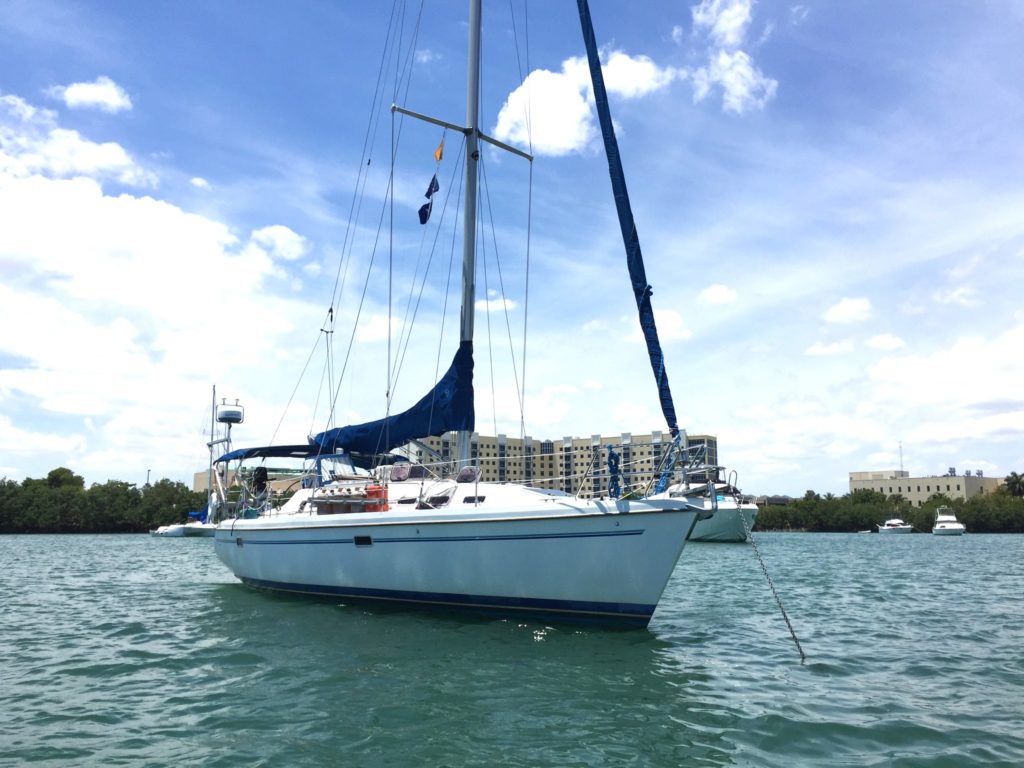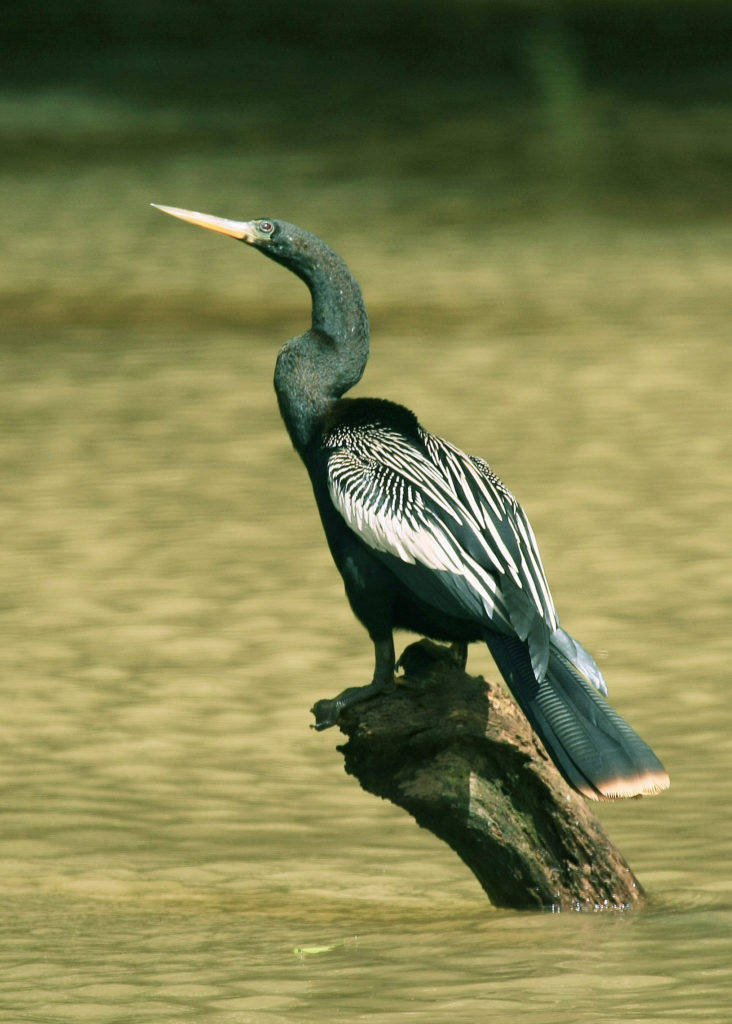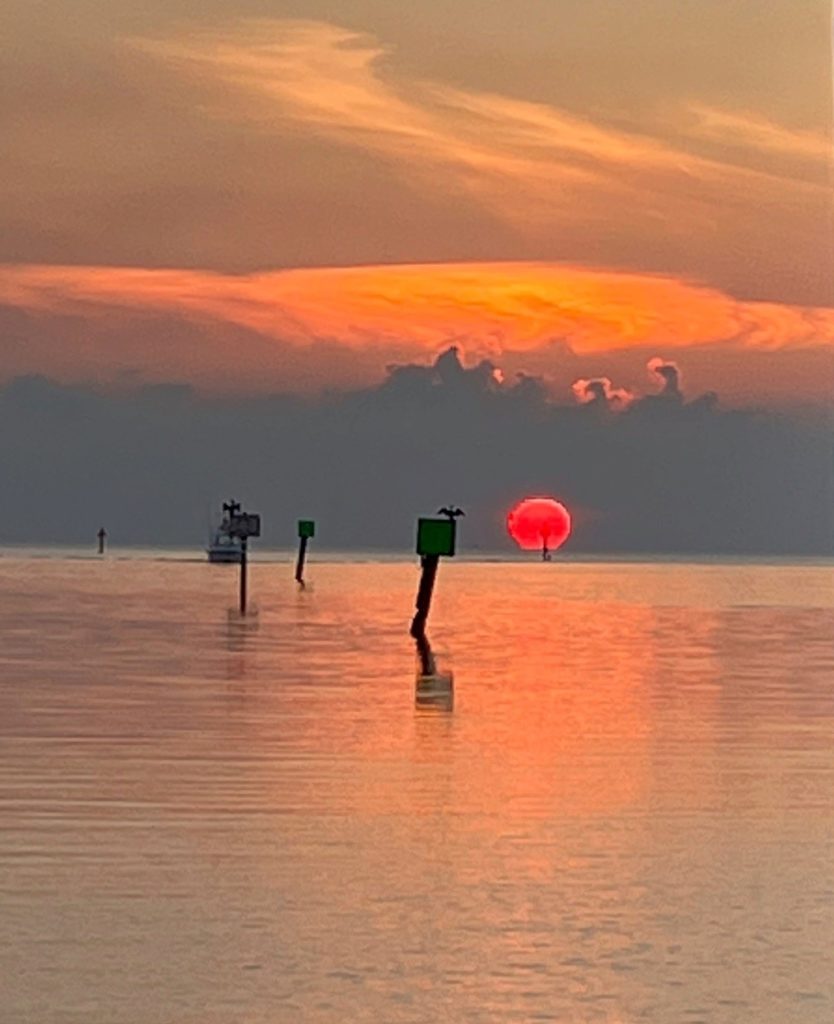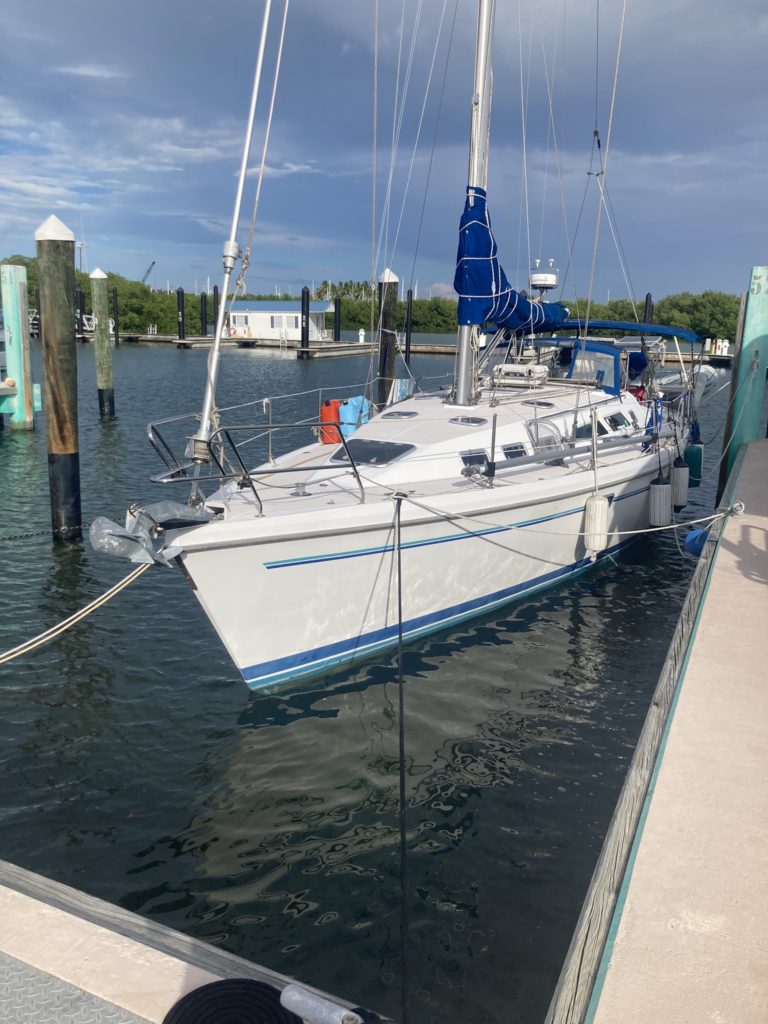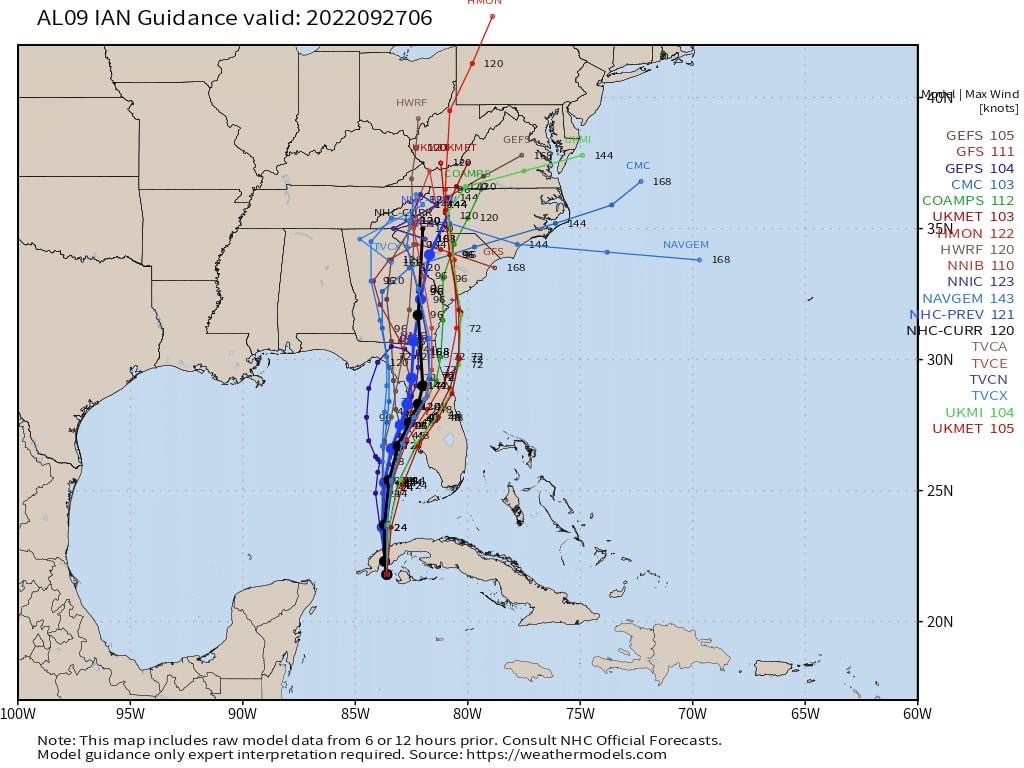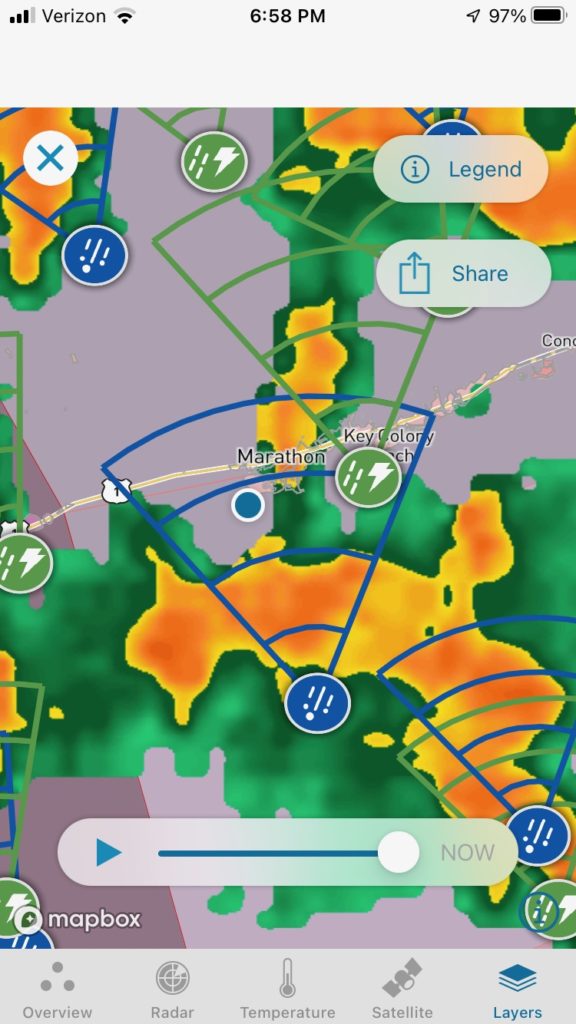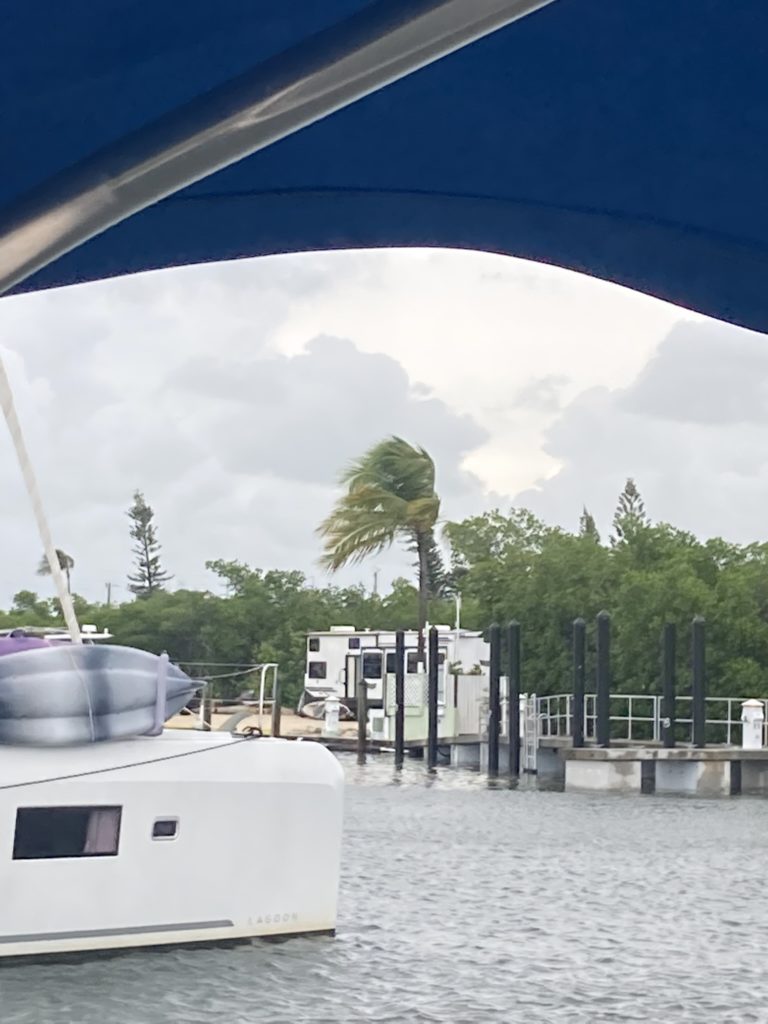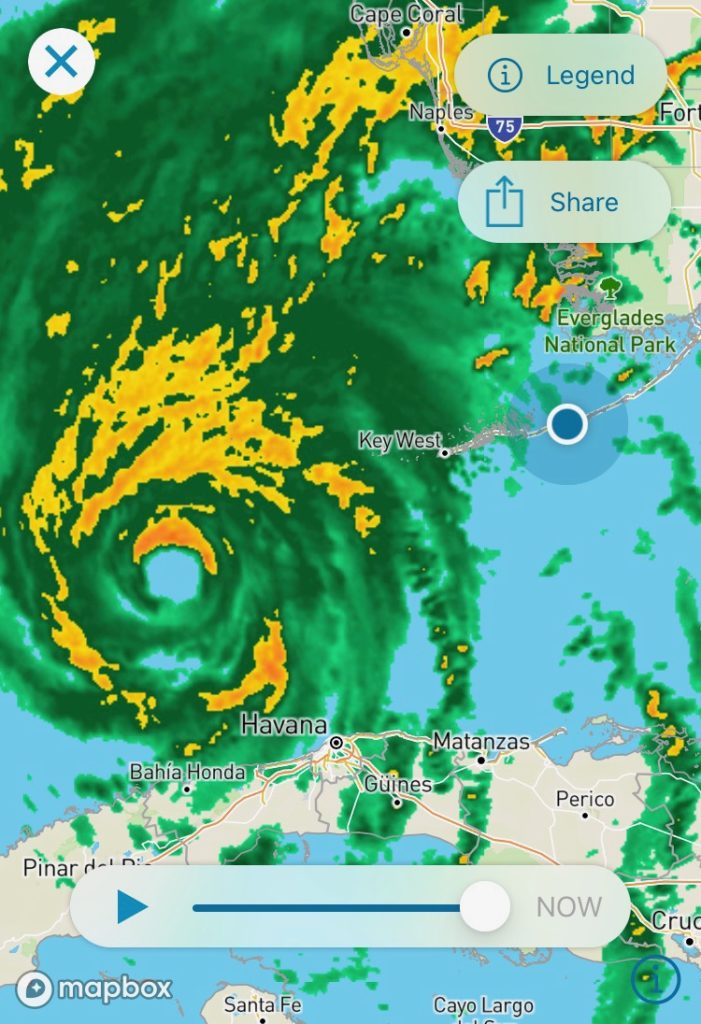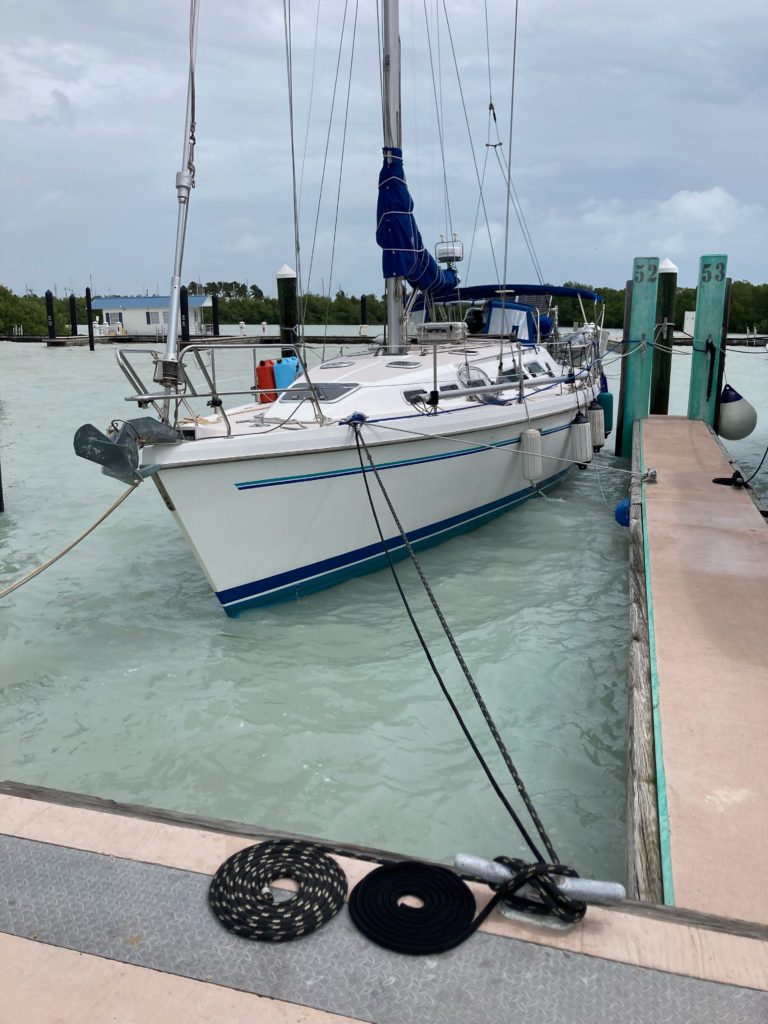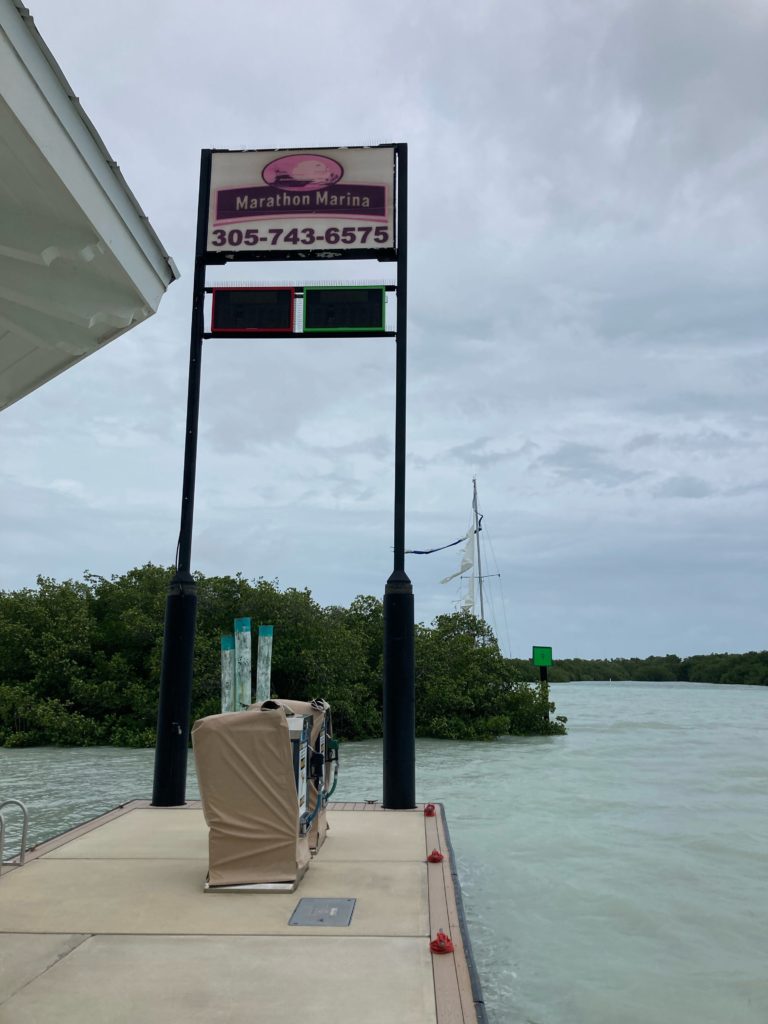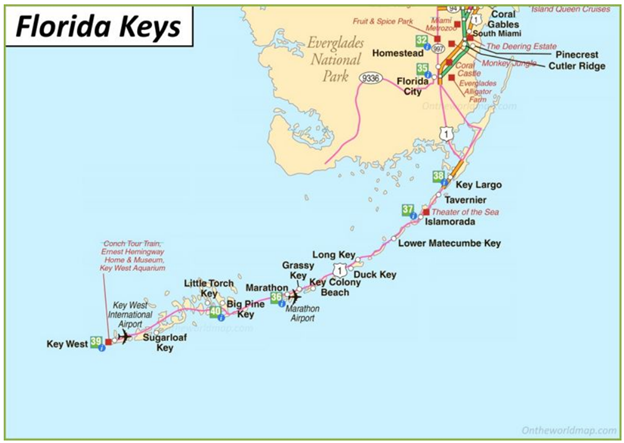Reasons for Moving
“In a field
I am the absence
of field.
This is
always the case.
Wherever I am
I am what is missing.When I walk
I part the air
and always
the air moves in
to fill the spaces
where my body’s been.We all have reasons
for moving.
I move
to keep things whole.”– Mark Strand, Keeping Things Whole
Our plan, to the extent that we had one, was to explore the quirky environs of Key West and take a week or so in the Dry Tortugas for some snorkeling and walks around the historic fort. Then, when the weather and wind were right, we would turn eastward and jump over to the Bahamas for a season. True to the cliché, “cruisers’ plans are written in the sand at low tide,” ours changed – for very good reason.
The trip to the Dry Tortugas required a favorable weather window, not only to get out to the remote site, but also to get back. The prevailing winds were from the east and north, so sailing there could be fairly easy but sailing back, beating our way into the wind and waves, could be a nightmare.
We had friends who got smacked down by a waterspout during a storm at the anchorage there, and we didn’t want to experience that firsthand. They were okay; they were able to turn the engine on and motor hard into the wind, avoiding being beached. Of the six boats anchored that night, three ended up on the sand.
Key West
As we waited for favorable weather, we survived more than four months in the Garrison Bight mooring field of Key West. It was a rough way to live; we were buffeted by north winds almost constantly, had infrequent pump outs, and often got soaking wet just crossing the mile of choppy water to the dinghy dock. Phil’s review of the location on Active Captain featured two stars:
Exposed and often uncomfortable
The mooring field is completely exposed to the prevailing winter winds from the north, which makes living on the ball often uncomfortable and sometimes unsafe in a north wind. Very windy and wavy. We were there for four months. I kept a spreadsheet and recorded that 1/3 of the days had small craft advisories. Dinghy travel to shore typically involves full foulies or a swimsuit since the salt spray is unavoidable. There was one fatality from a neighbor taking her dinghy to her boat while we were there. Pump out is supposed to be weekly, but could be delayed to two weeks or more due to weather. Very little communication from the marina office. The mooring balls have NO PENNANTS, making picking up the mooring ball difficult except in calm weather.
Despite the difficulties, we enjoyed Key West’s unique vibe, its “fabulous” restaurants and bars, and the chance to be locals. We changed our drivers’ licenses to a made-up Key West address, since the mooring field itself was not acceptable for that purpose. (We used the address of the dinghy dock.) We started asking for the local discount at the bars after a bartender at the Harry’s Hair of the Dog Saloon told us most places take 10% off for locals.
We climbed the Lighthouse, toured the Coast Guard ship and the Truman Little White House, marched in the locals parade before Fantasy Fest, and placed a few “Catmandu” stickers in our favorite bars. We ate and drank our way down Duval Street and then explored restaurants on the back streets and narrow walkways.
We found the best Italian place (Only Wood Pizzaria Trattoria down a brick-lined alleyway off Duval St.), the best Mexican (Old Town Mexican Café, open-air patio with a tree for a rooftop), best vegetarian (The Café, friendliest staff in town) and attended the Friday night sound checks at The Green Parrot. We bought the T-shirts.
Toward the end of our stay, we realized we were never going to get a good enough weather window to visit the Dry Tortugas. We decided to try again in another year, another season, sometime in the future. We had good reasons for not going.
We welcomed my son Anthony and his wife Maeghan for a February vacation, opting for a week at a dock instead of subjecting them to travel through the mooring field. (The week at the Key West Bight Marina was nearly $1,200.) We took them to the Brewery for lunch, and they presented me with a morse-coded gold bracelet. Phil whipped out his “decoder ring,” and it took two letters for me to start crying with joy: G-R. Grammy! They brought me a gift like no other: a grandchild on the way, my first.
When March came, it was time to move. We had spent all the fun chips Key West had to offer, and we were tired of the mooring field. We had other reasons for moving, and slowly, sadly, we were realizing our dream of a spring season in the Bahamas would have to wait.
Key West to Key Lois to Marathon
We set out for Marathon two days after dropping the “kids” at the bus station. We had just been sailing with them a few days earlier, so it was fast and easy to leave the dock. We followed our October course in reverse: out of Key West Bight, left to the channel, past the harborside resorts and bars, past Wisteria and Tank Islands, and into Hawk Channel.
The winds were light from the ESE, so we motored the 21 miles to Lois Key. Along the way we kept our eyes out for wildlife and saw several Portuguese Man-of-Wars, the blue-tinged floating blobs you want to avoid while swimming. Although we were using the autopilot, we had to hand-steer around scores of annoying little crab-pots. At just after 1 pm, we saw Lois Key in the distance and at 1:45, we dropped anchor there in 10 feet of water.
The winds had died down to about one knot, and seas were calm. We saw one large turtle break the surface near the stern as we relaxed in the cockpit. He dove again a minute later. Just before sunset, four large dolphins appeared from the east and swam under the boat. They came up on the other side, close to the cockpit. We watched them as they swam off to the west together.
Sunset was little more than an orange-pink glow in the western sky, and when darkness fell, it was intense. There were so many bright stars, but the only man-made lights came from the keys to the northeast. We could still see a faint glow to the west from Key West, but it was still a very dark night. The next morning, we had coffee and breakfast bars at 7:30 and then tried to pull the anchor. The anchor windlass failed to turn on. “I guess it’s arm day on the boat again,” Phil said, and muscled the heavy chain and anchor onboard at 8:40.
The wind and waves were calm as we motored toward Marathon. The ocean was flat with tiny ripples that sounded like turtles breaking the surface, but when I looked, it was nothing but water. I was at the helm for most of the day, giving Phil a deserved rest. We recognized land features to our left, sailing by the Bahia Honda Bridge and then the Seven-Mile Bridge as we approached Marathon. Since there was a waitlist for the mooring field, we anchored along the west coast of Boot Key at around 1:45 in the afternoon.
The next day, we boarded a bus for Key West, retrieved our car and closed our PO box. On the way back, we got a call from the city marina – our mooring ball was ready: Romeo 8. It was easy to grab the pennant this time, and we settled in to our new home in Boot Key Harbor, near the entrance to Sister Creek. Ospreys and bald eagles were calling overhead, and later that afternoon, dolphins came to meet us.
I have already written my Love Song to Marathon, and Phil wrote a tribute to its many tiki bars. Nothing in the next six weeks changed my mind about this worthy cruisers’ destination. On the mooring balls, a community of helpful, friendly, concerned citizens take to the radio every morning at 9 and share the news of the day: upcoming activities, people coming and going, people needing help, and truly corny “Dad” jokes. We met friends at the Friday night happy hour that we will reconnect with, down the line. But this is a sailing blog, and by mid-April, it was time again to go sailing.
Other Reasons
To explain our reasons for moving, for not going to the Bahamas, and for heading north, I have to go back a few months. While we were hanging on to the mooring ball in Key West, I had a few medical tests done that I had put off for too long. One of these was a mammogram, followed by a biopsy. Here is an excerpt from my journal:
Feb. 1, 2024: I guess I will remember this date for as long as I live. It’s the last day I woke up without cancer.
The doctor called me and asked how I was, any soreness, swelling. Then she said, “The tests came back positive for malignancy. There are cancer cells in the breast and the lymph node.”
Pause. Breathe.
“It’s invasive ductal carcinoma and it’s metastatic,” she says quietly.
Phil is listening so I stay quiet while she tells me to pick up a CD of my images at the doctor’s office and make an appointment right away with an oncologist. She recommended Baptist Hospital Breast Cancer Center in Miami.
“Okay,” I said. “Is it treatable?” Then Phil got up and put his arm around me.
“Yes,” she said, and added, “I was pretty sure this would be the result. Sometimes I hate being right.”
Phil held me while I explained what she had said. I cried a little. I guess I’m allowed. I have metastatic breast cancer.
So, instead of planning a crossing of the Gulf Stream and a season in the Bahamas, we were planning a way to get closer to my oncologist, my future treatments, and an affordable dock where we can spend the hot hurricane season with air conditioning.
Some treatments were available at Fishermen’s Hospital in Marathon, so we headed for the mooring field there. Weekly treatments would start in mid-May in Miami, so we called our previous home, Loggerhead Marina in Hollywood, and asked about a slip.
“Your old slip will be available,” the manager said. “When will you be here?”
“Mid-April,” said Phil. It gave us six weeks in Marathon, where we could get some treatment, and it was closer to Miami, where we would be going for tests and appointments.
I am going to be a grandmother. Phil and I are sailing to the Bahamas next spring. Our plans have to be rewritten, in the sand, but these things will remain even after high tide.
We all have reasons for moving.
Having a Ball in Key West
– Attributed to Horace Greeley“They must often change, who would be constant in happiness or wisdom.”
– Confucius
“Go West, young man.”
After 15 months at Safe Harbor Marina Marathon–with just a few sailing excursions into Hawk Channel– we took our dock rug, hoses, and electrical cords and prepared to sail away. Our friends Guy and Pam were there to help with lines, and it was sad to say goodbye. Phil backed out of the slip that early Saturday morning while I put away the lines and fenders. We wouldn’t need those where we were going.
Day One: Marathon to Key Lois
It was still, calm and sunny with no wind as we motored past the familiar vessels in the marina for the last time. We passed the boat wreck where cormorants, pelicans and ibises had entertained us as we watched them preening or fishing, or just drying their wings. Last week we watched every other species scatter as a bald eagle landed on the wreck with his fish dinner. Soon, his partner swooped in to share the leftovers. The panicked cormorants swam away in a tight group of about 20 birds, safety in numbers. There was no doubt as to who rules the roost. (We will miss the roost.)
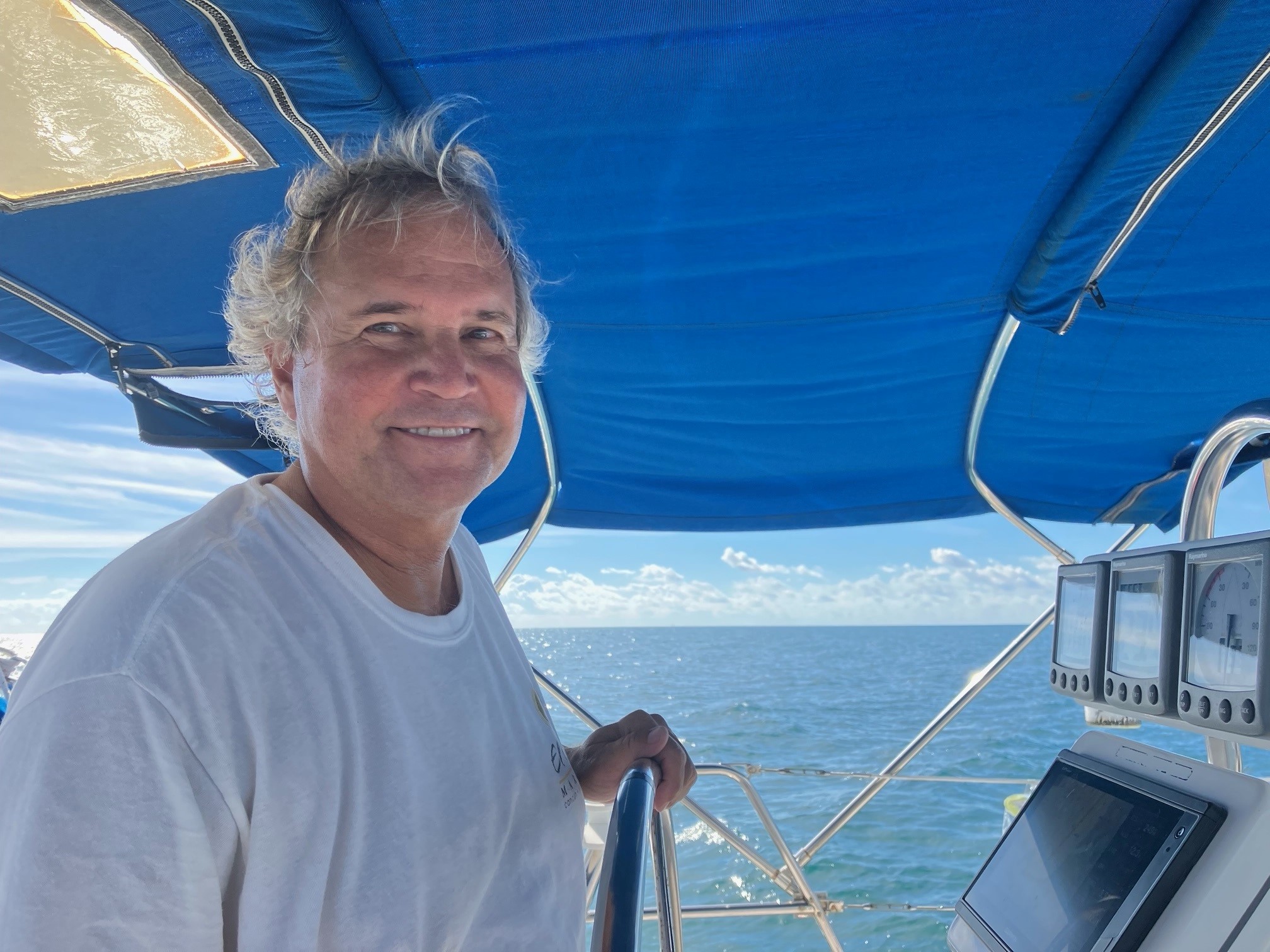
The sea was as flat as it gets, so the boat moved smoothly through the morning. We saw dolphins for a few minutes, surprising since we hadn’t seen any in Marathon since around June. The smart ones must have moved on to cooler waters. Our poor seasick cat tossed her Friskees under the salon table and curled up under the aft bed. She is 19½ human years old, so we forgive her.

Phil had plotted a two-day course to Key West using paper charts and our Garmin chart plotter, so it was easy to navigate. We put Otto the autopilot on and with minor course corrections for the numerous crab pots, we made our way west to the first night’s anchorage at Key Lois (aka Loggerhead Key), arriving in early afternoon.
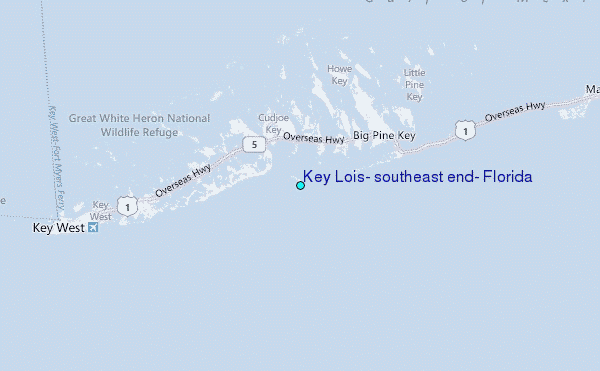
When we found a good spot to drop the anchor, I took the wheel and steered into the wind. However, I was not very good at keeping it there, and the boat kept turning. I’m working on that. We did manage to anchor in nine feet of water and turned off the engine. We were the only boat in the anchorage. A frigate bird, with its M-shaped wingspan and swallow tail, paid us a visit wheeling close to the mast on its way around the boat. We didn’t kill it and eat it, so I think it was a good omen.
When night came, we barbecued our veggie burgers and had celebratory gin and tonics. The half-moon lit up the sky, and the stars – so many stars – were brilliant. In the distance, we could see the glow coming from the lights of Key West, the only sizable community in the lower keys. The boat was rolling side to side, but we didn’t really notice until we went below. For such calm seas, we didn’t know why it was so roll-y. With the hatches open and a breeze blowing through, we slept like babies in a giant rocking cradle.
Day Two: Key Lois to Garrison Bight Mooring Field
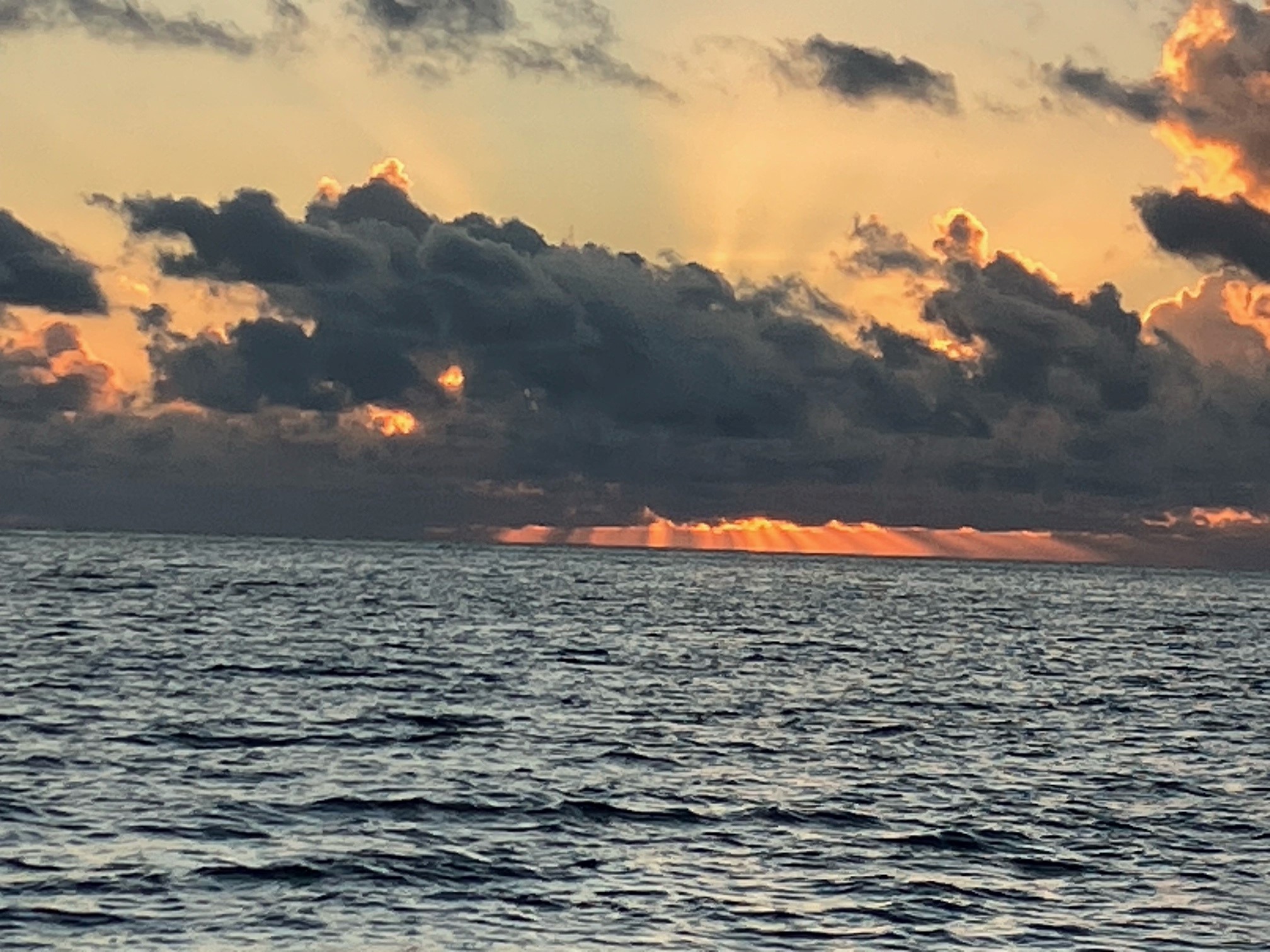
I awoke before dawn and fed the meowing beast before settling outside to watch the sun rise. Phil made coffee in the French press, and we toasted bagels for breakfast. It was a sunny, cool morning with a better breeze, so we were anticipating a sailing day. Sure enough, as I motored into the wind and Phil pulled the anchor, we felt the rise of wind out of the east. The wind predictions (notoriously unreliable) were for northerly winds, but any wind that allowed us to raise the sails and head west was a blessing.
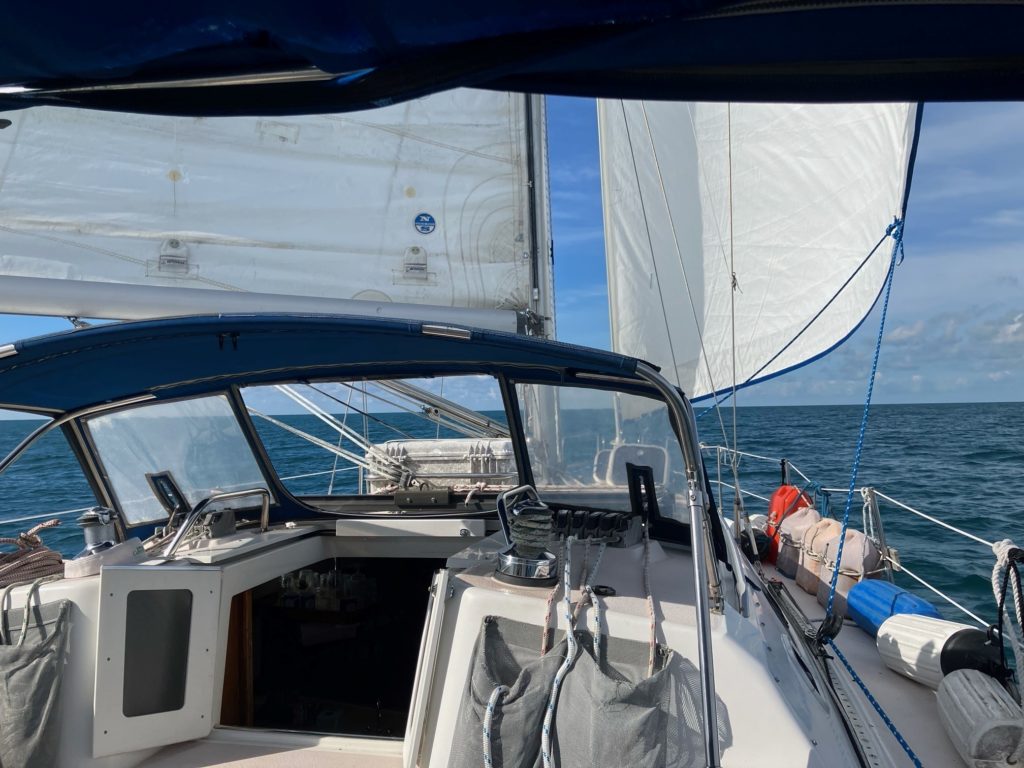
We sailed downwind with the mainsail pulled to the left side and the foresail to the right. This arrangement is called sailing “wing on wing,” as the two sails look like wings pulling the boat along. We occasionally hit 4.5 knots in a 10 or 12 knot breeze, but mostly cruised along dodging crab pots at 3 to 4 knots. It was peaceful and relaxing. We passed the keys we often traversed on our many trips down Route US1 from Marathon and saw the million-dollar mansions lining the beaches, which aren’t visible from the Overseas Highway. We sailed for more than ten nautical miles.
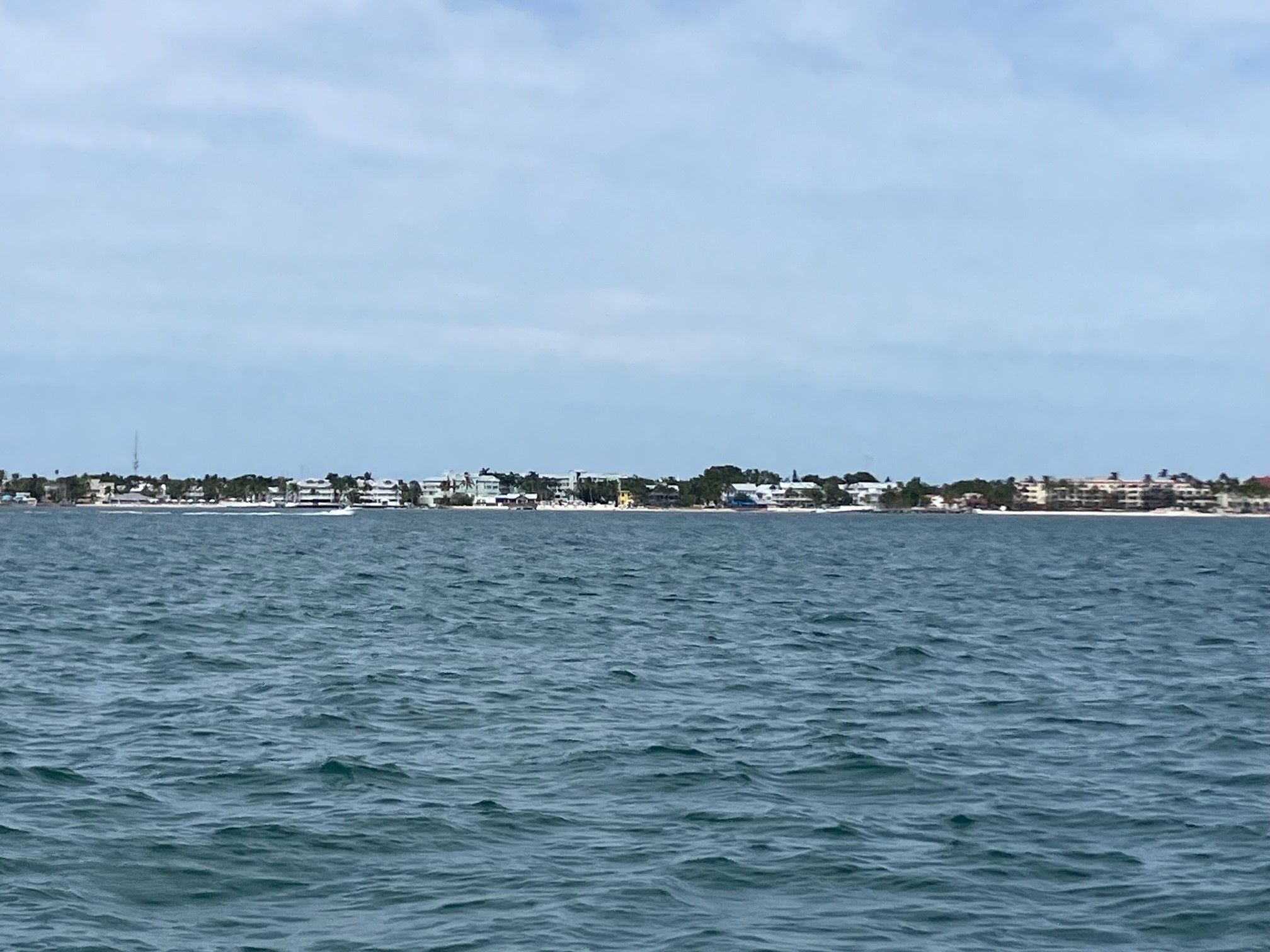
Welcome to Key West
When it was time to enter the Key West channel, I pointed into the wind and Phil dropped the sails. As usual, I couldn’t keep the boat from spinning too much, but I did a much better job this time. So that counts as progress. Phil got us back on course and we made the right turn at the end of Key West. That’s when the wind picked up and we saw wind speeds of 13 knots just when we didn’t need it. A narrow, busy channel is not a great place to rely on your sailing skills.
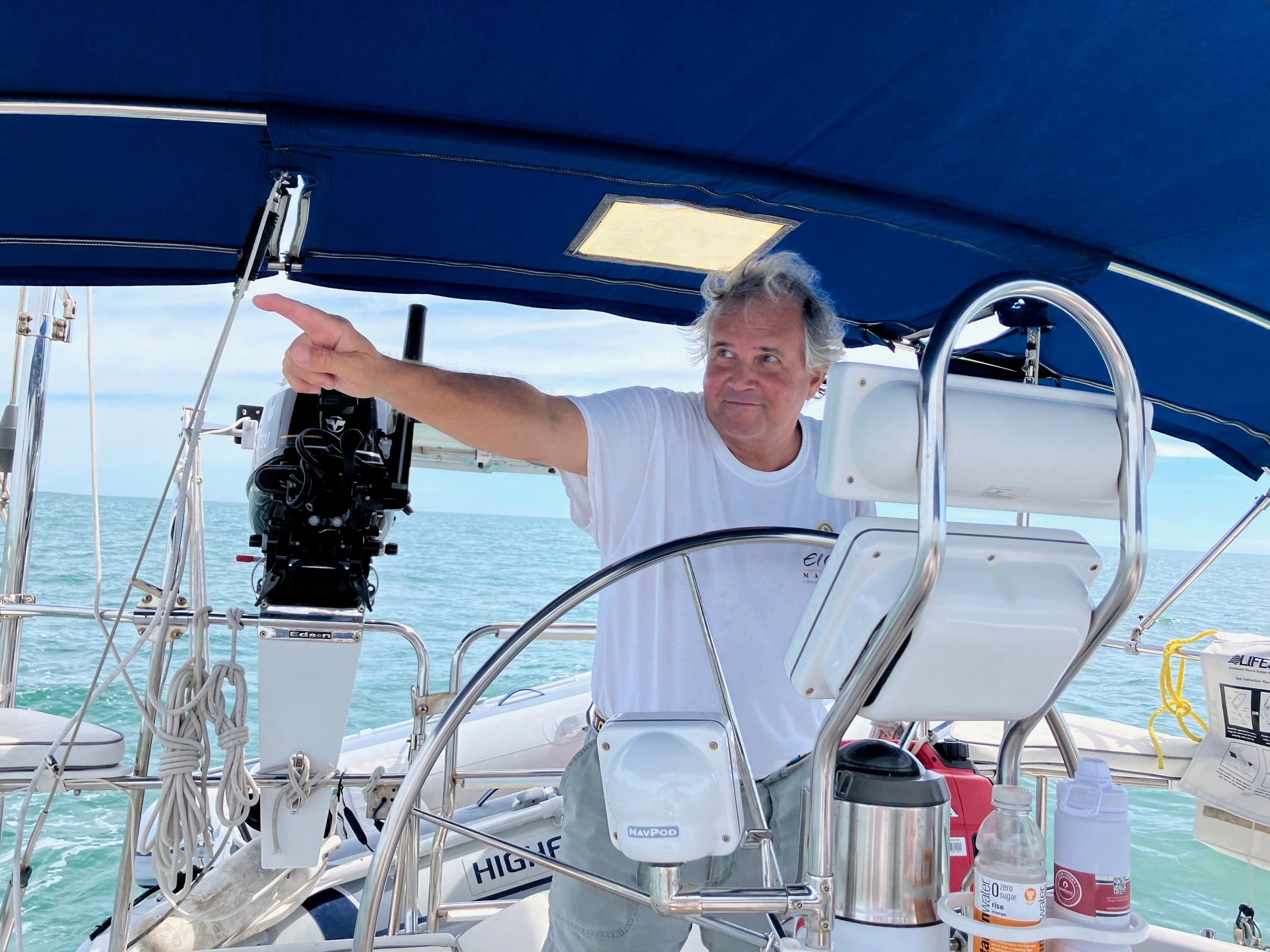
We motored through the channel between Tank Island and Key West. I made a little video of this passage as we tried to pick out the landmarks we knew: Galleon Resort, Southernmost Point, Mallory Square, Sunset Pier with strains of live music coming across the water.
We passed Wisteria Island (a much better island name than Tank, don’t you think?) and entered a narrow passage to make our way around the northern end of Fleming Island and south into our mooring field. A small motor boat pulled directly across our path as we made the turn, with no one onboard looking in our direction. (We didn’t sound the air horn. Phil is kinder than I am when it comes to inconsiderate boat captains.)
It was around 3 pm when we started searching for an empty mooring ball. The mooring field between Fleming and Sigsbee islands holds 149 mooring balls, chained securely to the bottom of the harbor. Boats hook their strongest lines to a ring at the top of the ball and hang on without anchoring. We were told there would be balls available, but we wandered through rows of moored boats and finally found one – but it was broken.
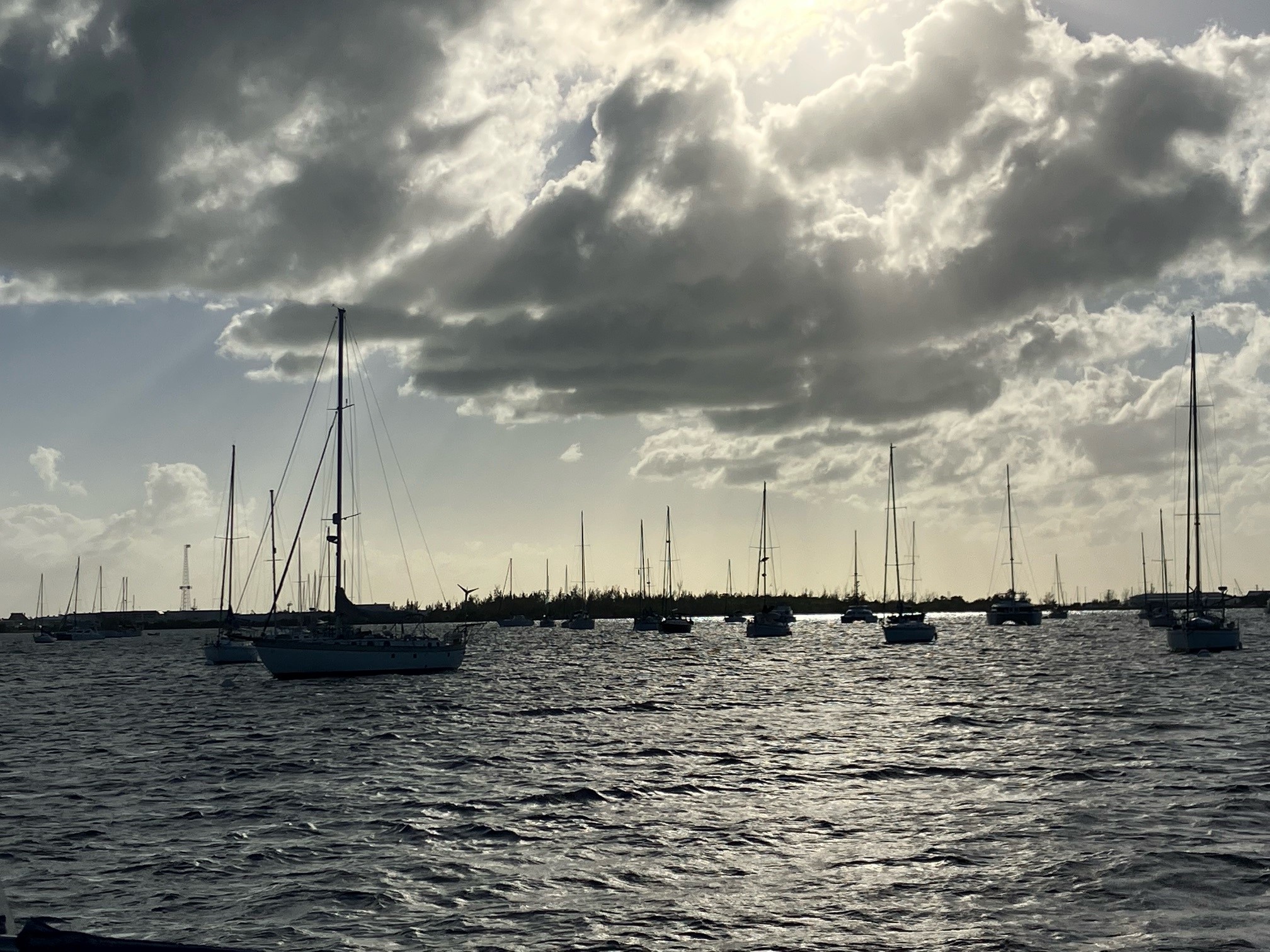
Finally, at the far northeastern end of the field, we found two available balls. Phil drove up to one very slowly and left me at the helm to get him as close as possible to the ball. He had a boat hook to grab the line, a tricky maneuver even with his experience, and trickier still in the brisk wind. As I got too close to the ball, he yelled “neutral,” indicating that I should downshift. Only I couldn’t budge the shift lever and I panicked. “It won’t shift!” I said, as we drifted past the ball. Phil came to my rescue, and figured out that the engine was revving too fast to shift, so I relearned that important lesson.
Feeling like a mooring ball failure, I let Phil spin the boat around to approach the ball a second time. This time, I was driving so slowly, Phil was able to lasso the ball, muscle it up so he could reach the ring, and attach a mooring line. We were home.
Right away, the man in the adjacent boat introduced himself. “Hi, I’m Jack,” he yelled across the water. “Phil and Kay,” we answered and waved. He appears to be living alone on his boat (which I thought was named “Arrer-ten”) and maybe he was lonely and glad to have a neighbor. Phil chuckled when I asked him what Arrer ten means in French. “After Ten,” he said. The “f” and the “t” had worn off at the top.
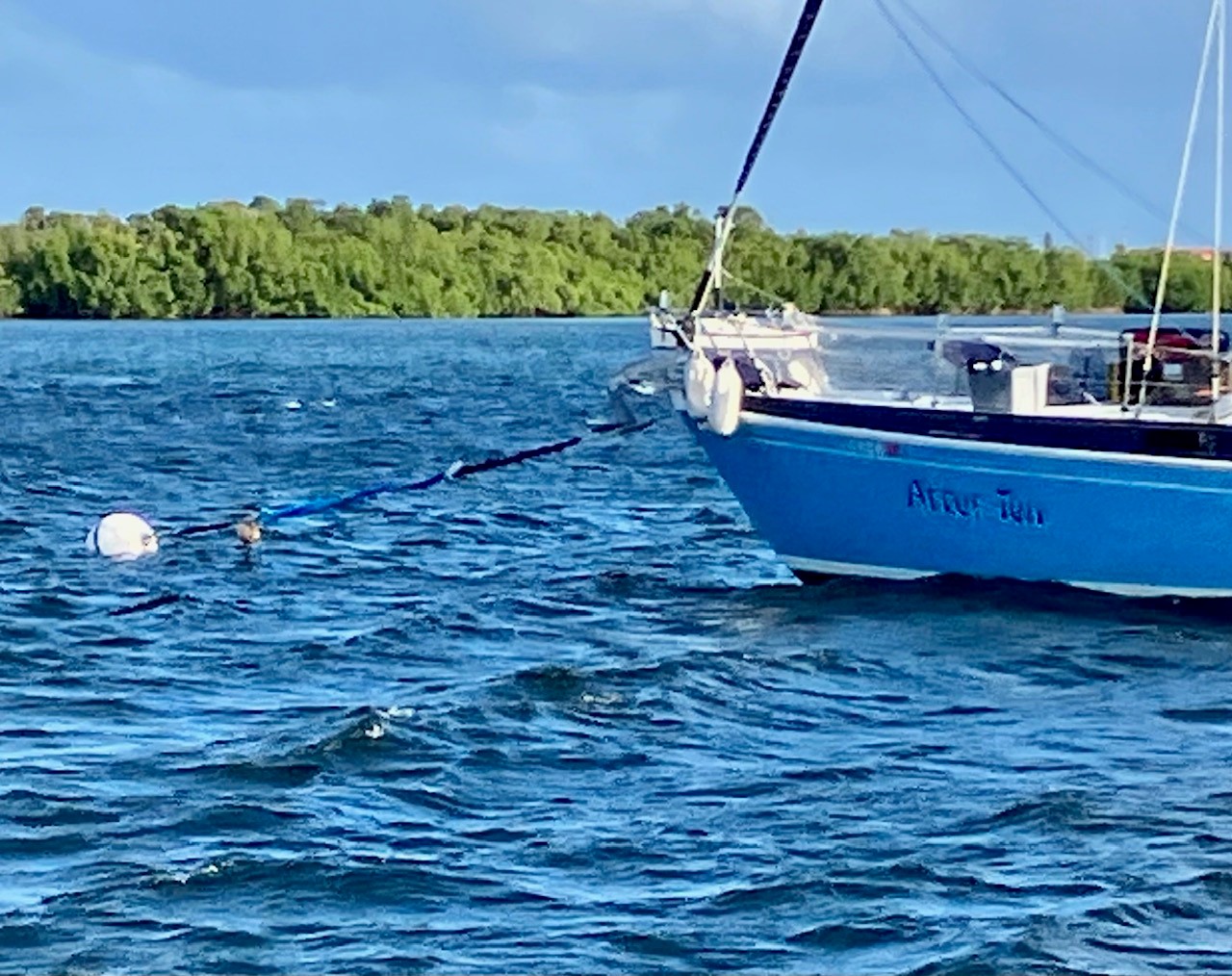
We had just a couple more things to do: check in with the dockmaster, and have dinner. The dockmaster was a half hour dinghy ride away, but we found the right channels in the unfamiliar harbor and caught him just in time. He introduced himself as Beaver and collected $424 for a month of mooring, showers, laundry, dinghy dock and pump-out service. “It’s the only affordable housing in Key West,” he said.

Thai Island Restaurant was open, so we headed up to the outdoor seating area and got acquainted with our server, Roger. He was another Key West character, the interesting and unusual people we keep finding in our new community. (Read more about “Quirky Key West“) Roger, self-described as “fabulous!”, somehow got us to tell him our whole history, and he learned our names. We ordered two plates of delicious Thai stir fry and he brought a selection of sauces. I mentioned that one sauce was way too hot and he said, “Maybe you’re just way too white.” I wasn’t offended; he was joking. I think if your food hurts you, maybe you shouldn’t eat it.
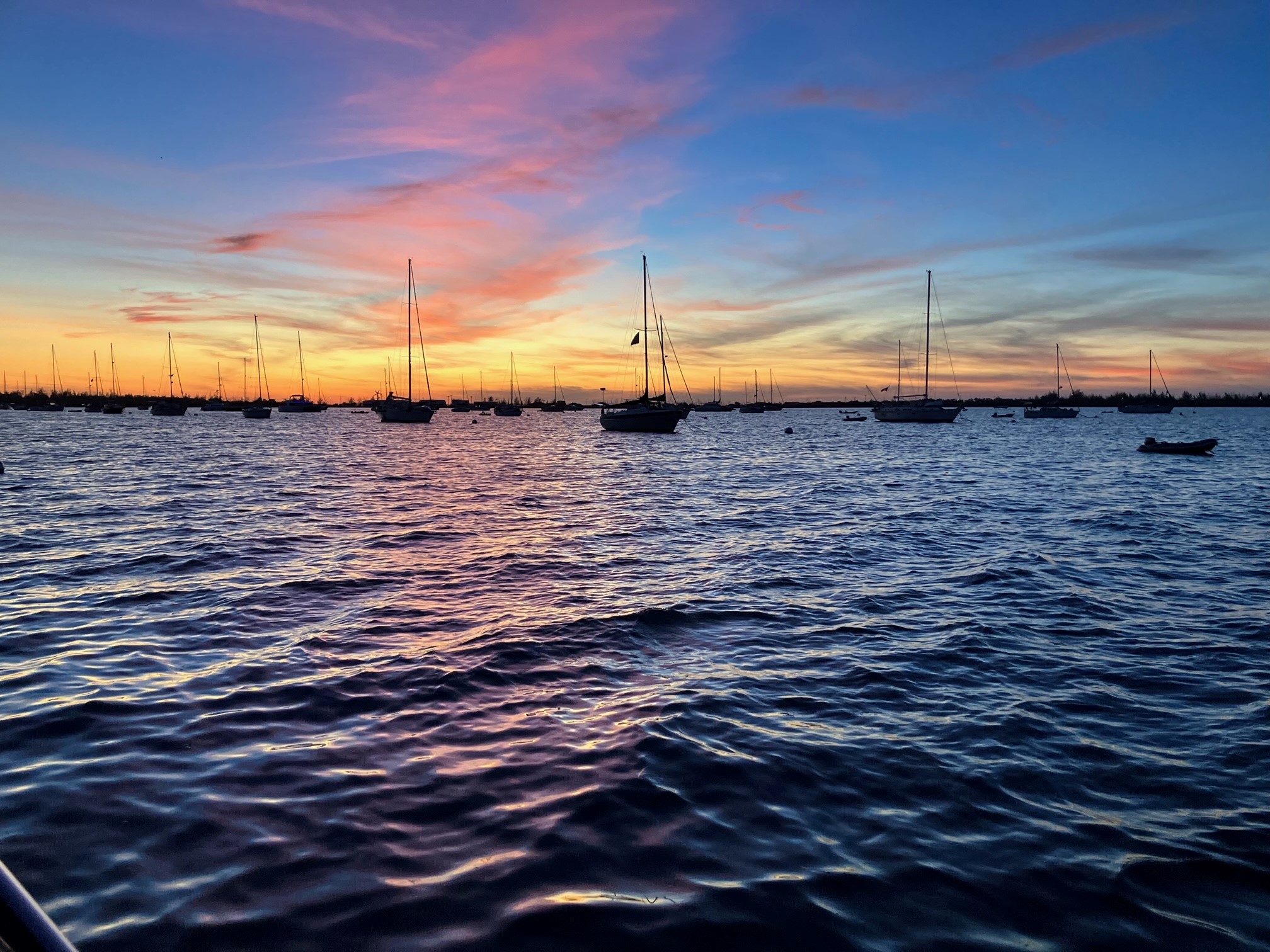
Back in the dinghy with my tiny take-out box, we made our way back to Catmandu before dark. As we rested in the cockpit and sunset approached, we heard strains of bugle or cornet music coming from the nearby naval base. They play a familiar tune five minutes before sunset, and then the trumpet sounds the “Retreat” at sunset, signaling that the workday is over. We sat quietly and listened to the trumpet from across the waters of our new home, a poignant ending to a very long day.
Guide to Tiki Bars of Marathon
Since Kay and I moved to Marathon, Florida, over a year ago, we have enjoyed exploring many of the tiki bars in the area by dinghy and by car. Why tiki bars? Tiki bars are bars in tiki huts. Tiki huts, in general, are magical. The Florida Keys are very hot in the summertime, and somehow the air under a tiki hut is always 5 – 10 degrees cooler than outside. Plus they look exotic and you feel like you are on vacation whenever you are hanging out in a tiki bar. Tiki bars do not have air conditioning, but they all have ample air circulation on all sides and fans are installed so they are comfortable all year around.
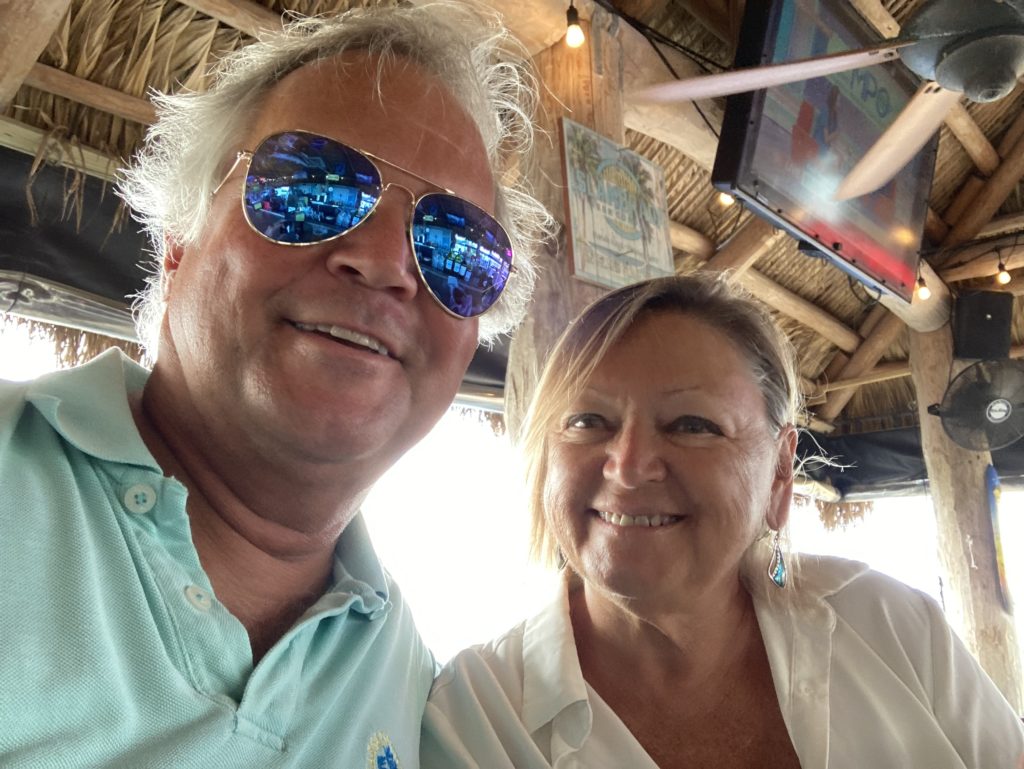
What defines a tiki hut? A tiki hut has a cypress log frame, open sides, and a palm thatched roof. Traditional, native American “chickee huts” are the same, except a chickee hut has a raised wooden floor. Fun fact: tiki huts or chickee huts built by Florida’s Seminole and Miccosukee tribes are exempt from the Florida Building Code and can be built without building permits.
Disclaimer: not all of the bars reviewed in this article are actual “tiki” bars, but they are still fun places to visit. Also, the list is not complete since there are so many of them and we have so little time. So please enjoy this article with a cold adult beverage in hand, and it will be okay.
Here is our guide starting — roughly — with our favorite bars in Marathon that are close to Safe Harbor Marina / Boot Key Harbor, and then expanding outwardly. Look for the hyperlinks in this article and click on them to get more information, like their web addresses, street addresses, phone numbers, and menus. Note that every restaurant in the Keys seems to specialize in seafood since it is so abundant here.
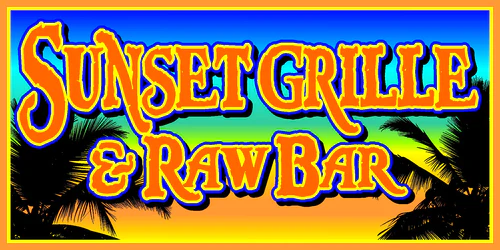
Sunset Grille. Located at the eastern end of the Seven Mile Bridge, Sunset Grille offers perfect sunset views, a huge menu of food and specialty drinks, its own pool, and a pool bar. The sturdy dinghy dock was rebuilt after Hurricane Ian last year, and is about a mile by dinghy from the marinas. The restaurant plays Jimmy Buffett’s Radio Margaritaville in the background all day. Service is always fast and friendly. Sunset Grille is the perfect place to go with friends and family.
Burdine’s Waterfront. Burdine’s is a smaller tiki bar restaurant with simpler fare on the second floor of a marina and fuel dock building. Burdine’s is best known for having the best french fries in the world. On the menu, they are “fresh hand-cut fries sprinkled with their special fry dust.” Burdine’s also has some tasty vegetarian entree options, and deep fried key lime pie. The restaurant is directly on the channel leading from the ocean to Boot Key Harbor, and boasts a floating dinghy dock. Sunset views are also amazing from this second floor tiki bar, and one can often see dolphins transiting the channel.

Castaway. Down one of the canals around the corner from Burdine’s is Castaway. To get there by water, you have to already know where it is, since you have to take some twisty turns. The restaurant is known for dishes made from lionfish, which is an invasive species. You are doing the Keys a favor if you take the lionfish out of the water and eat them. The dinghy dock at Castaway is sketchy, but it exists. Only the outdoor bar is decorated in the tiki bar motif.
Dockside. Dockside is the dive bar where you go to become a local. Situated on the waterfront on the southern edge of Boot Key Harbor, Dockside has the perfect floating dinghy dock, happy hour from 3pm – 7pm, and live music seven days a week. During happy hour, Bud Lite is only $2.50, wine is $3.25, and well drinks are only $4. You can have rounds of drinks, happy hour appetizers, and live music, and be hard pressed to spend $20 apiece. I would know, I have tried many times! But Dockside is so low key that it doesn’t even have its own website. It can only be found online on Facebook. Dockside is not a true tiki bar, since it doesn’t have a thatched roof. However, Dockside scores high for its location, waterfront views, low prices, good music, and the Keys vibe.

Lazy Days South. If your boat is docked at Safe Harbor Marina, you will surely patronize this tiki bar on a regular basis. Lazy Days is conveniently located only 60 feet from our boat and sits between the marina pool and the marina docks. In fact, bathers can get pool service by ringing a ship’s bell that the bar has installed outside. Lazy Days has a good happy hour, but is not a true tiki bar because it does not have a thatched roof. Also, their docks are not particularly dinghy-friendly since they are fixed rather high off the water.
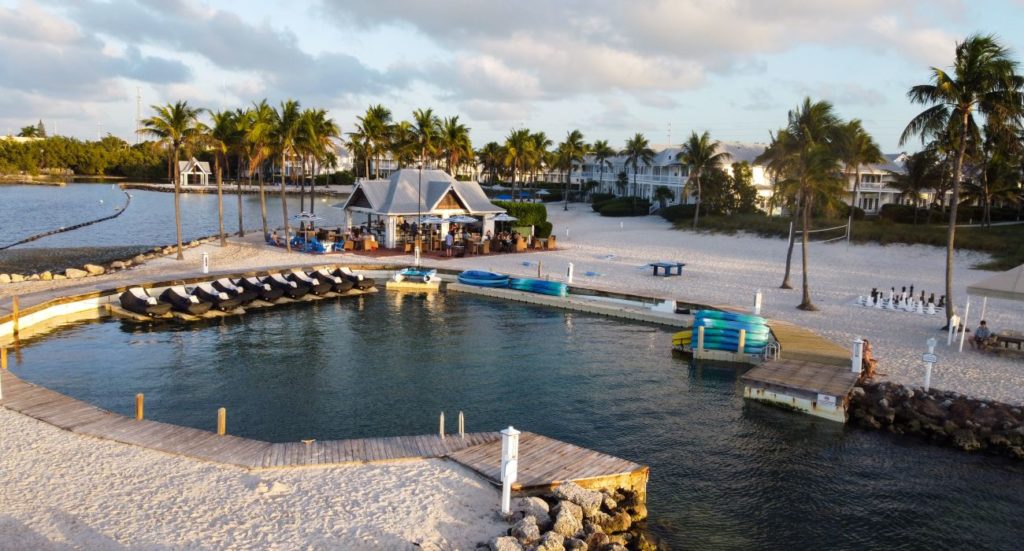
TJ’s Tiki Bar. TJ’s Tiki Bar is an upscale tiki bar located on the bay side of Vaca Key and is a part of the Tranquility Bay Beach Resort. There are great sunset views that frame the famous lighthouse at the nearby Faro Blanco Marina. TJ’s is on the water, but the docks are for watercraft rental only. Most of the seating is on an uncovered patio, and there is often a singer / guitar player providing live music. TJ’s is not a true tiki bar because it does not have a thatched roof. It is also the most expensive tiki bar we have been to. I once got a $28 charge for a veggie burger. I thought it was mistake … and it wasn’t.
Porky’s Bayside BBQ. Like TJ’s, Porky’s is also on the bay side of Vaca Key, but is much more low key and affordable than TJ’s. Instead of specializing in seafood like the other restaurants in Marathon, Porky’s specializes in pork barbecue. However, they have good size menu to satisfy almost every palate. Porky’s is a true tiki bar that is easily identified from the Overseas Highway, and has several dock slips on the water. New for 2023, Porky’s just opened an 18-hole mini-golf course, the only mini-golf course in Marathon.
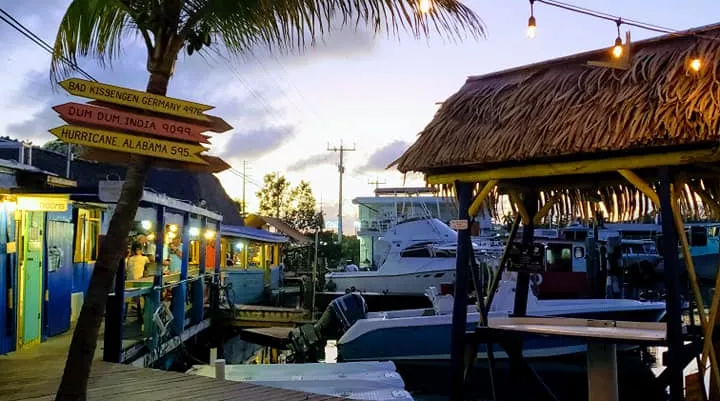

Barnacle Barney’s Tiki Bar. Hidden behind The Hammocks Resort on the bay side is Barnacle Barney’s, a hidden gem. It is a very cute bar on the water with friendly servers that is open to the public, but you cannot bring a boat here and it is not a true tiki bar because it does not have a thatched roof. No official website. Happy hour is 4 – 6 and the prices for drinks and appetizers are great.
Keys Fisheries. A true tiki bar on the second floor of a fish market, Keys Fisheries is another favorite of the locals. It is walking distance from the City Marina, which is very handy if your boat is on a mooring ball there. It is also on the bay side. Enjoy adult beverages while watching the fishing boats bring in their catches at the marina below.
Island Fish Co. Turning toward the north / east end of Marathon, Island Fish Co. is a true tiki bar on the bay side that is the only restaurant that can be reached by land, sea, and air. There is a helipad on the north end of the parking lot.
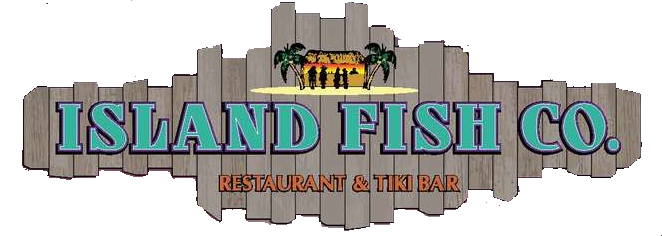
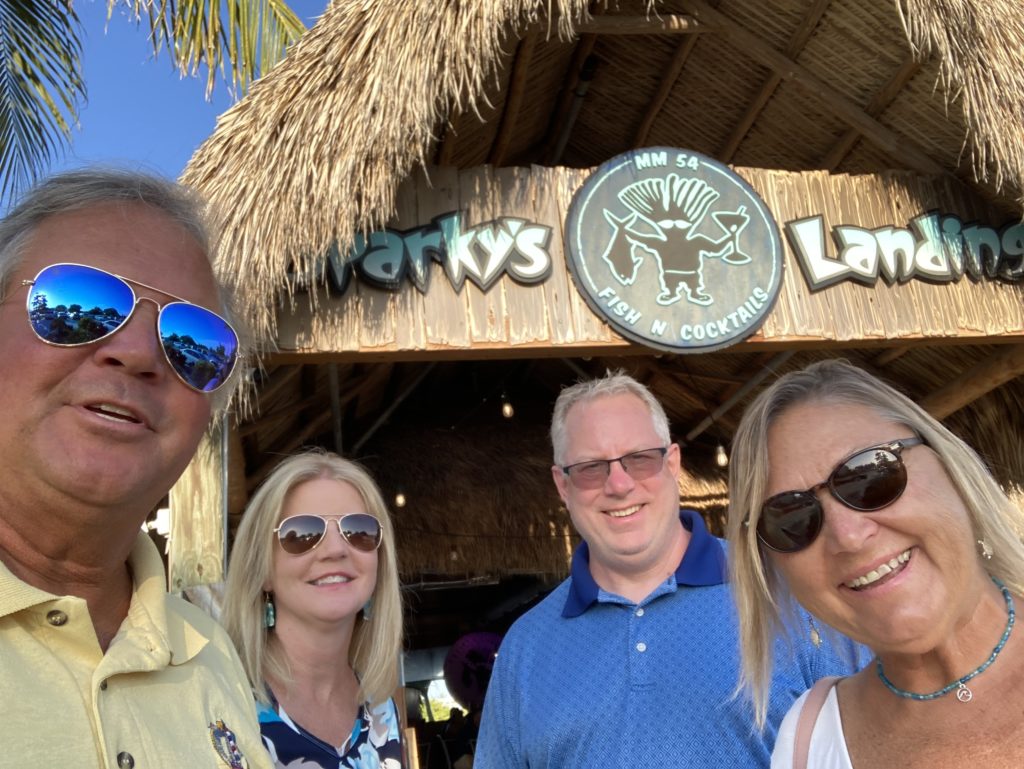
Sparky’s Landing. On the north / east end of Marathon is one of the best tiki bars in town. A true tiki bar on the ocean side, you can take your dinghy to their dock, but you would have to cross five miles of open ocean to get there. Sparky’s Landing has a very large menu that includes excellent brick oven pizzas. Their live music offerings are the best quality music acts in town, and include Marathon’s former mayor, singer/songwriter John Bartus. Like Sunset Grille, Sparky’s Landing is a great place for groups.
Suck, Squeeze, Bang, Blow
“Diesels have an unrivaled record of reliability in the marine environment.”
— Nigel Calder, “Marine Diesel Engines: Maintenance, Troubleshooting, and Repair”
“The test of the machine is the satisfaction it gives you. There isn’t any other test. If the machine produces tranquility it’s right. If it disturbs you it’s wrong until either the machine or your mind is changed.”
— Robert M. Pirsig, “Zen and the Art of Motorcycle Maintenance”
As Kay wrote in her blog post Night Passage to Marathon, we limped in to our resort marina back in August with an engine pouring out white smoke and producing only low power on a twenty-hour overnight passage. It was an ordeal, but we had made it to our new home. After settling in at our marina, we started researching mechanics who could come and fix our engine. The closest Westerbeke reps were back in Miami and Fort Lauderdale who were not particularly interested in helping us when we were bobbing around on the anchor at No Name Harbor for five nights. I knew we could do better. We had to do better.
One morning, I chimed in on the Boot Key Harbor Cruisers’ Net that is broadcast every morning on VHF channel 80. I asked for help. The one mechanic that everyone recommended was the famous Diesel Don. I called him on the phone, and made an appointment to have him take a look.
Diesel engines, such as our Westerbeke 42B Four, are typically four-stroke internal combustion machines that operate according to four simple processes: suck, squeeze, bang, blow. If any of these processes do not occur, the engine does not run.
Suck: the piston sucks a mixture of air from the intake manifold and atomized diesel fuel from an injector.
Squeeze: the piston squeezes the diesel and air into a very small volume, on the order of 400 psi, which also heats them to a very high temperature.
Bang: when the temperature exceeds the self-ignition temperature, the mixture explodes with a bang, driving the piston downward with the expanding gas and rotating the crank shaft.
Blow: the piston blows the exhaust products out the exhaust manifold and toward the muffler.
Over a series of visits, Diesel Don tried all the less-expensive tests and fixes that could cause the white smoke and low power output conditions. First, he took off the valve cover and adjusted all the valves. Wasn’t that. (Please note, we are going to show some of the guts of the diesel engine below. If you are squeamish about engine guts, please avert your eyes.)

Next, we replaced all of the injectors. Wasn’t that.
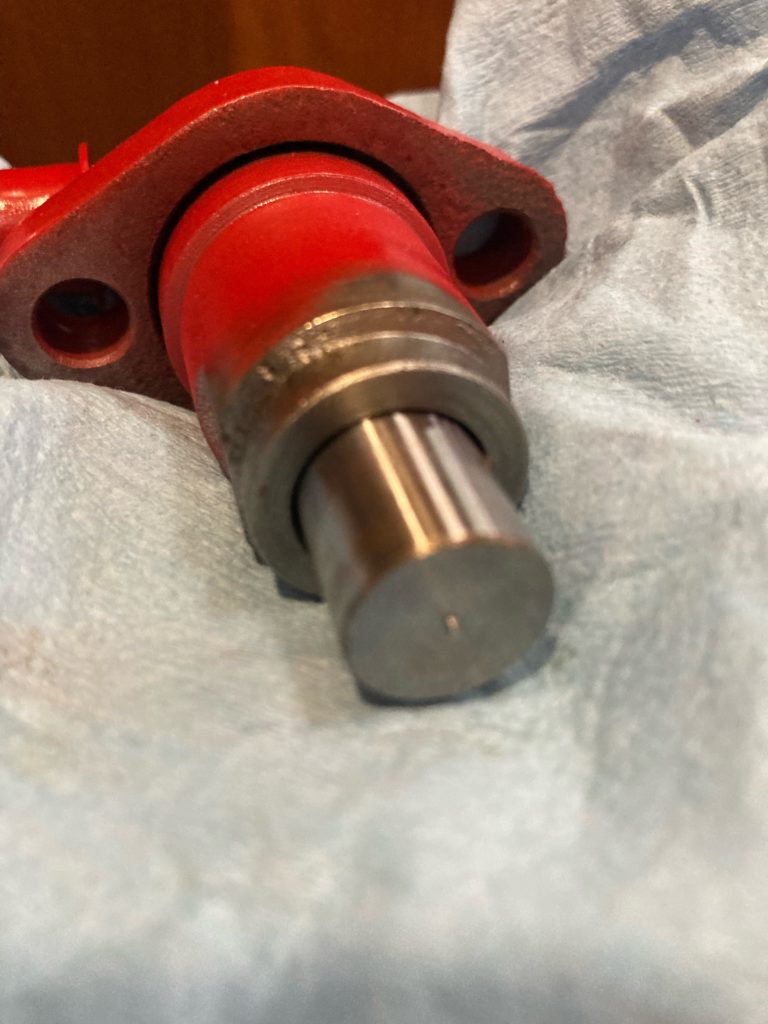
Then, we decided to do a compression test of each cylinder. Cylinders 1 through 3 were in spec, but cylinder 4 had no compression whatsoever. That is, no squeeze.
There is a short list of conditions that could cause a lack of compression in one cylinder and not the others: blown head gasket, bad valves, bad piston rings, and broken piston connecting rod. Resolving any of these issues requires major engine surgery. Resolving some of them would require removing the 450-pound engine from the boat somehow and taking the engine apart in a machine shop. I hoped we could avoid having to remove the engine. That would mean towing the boat to a boatyard with a big crane to get the engine hoisted out, and then living in a hotel for week or two while the engine gets fixed.
Don and I rolled the dice and decided to remove the cylinder head at the marina, since maybe it could be fixed in place. The photos below showed the problem immediately: broken exhaust valve on the number four cylinder. The diesel fuel and air mixture was being pushed out the exhaust without being combusted, which created the white “smoke” we were seeing.
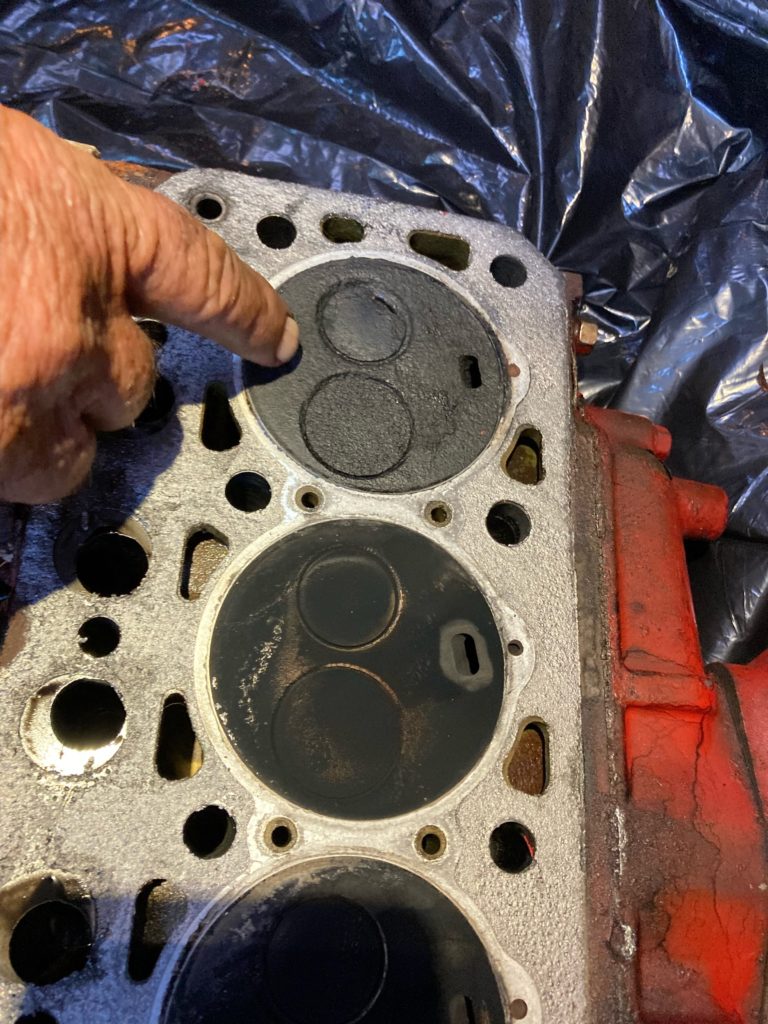
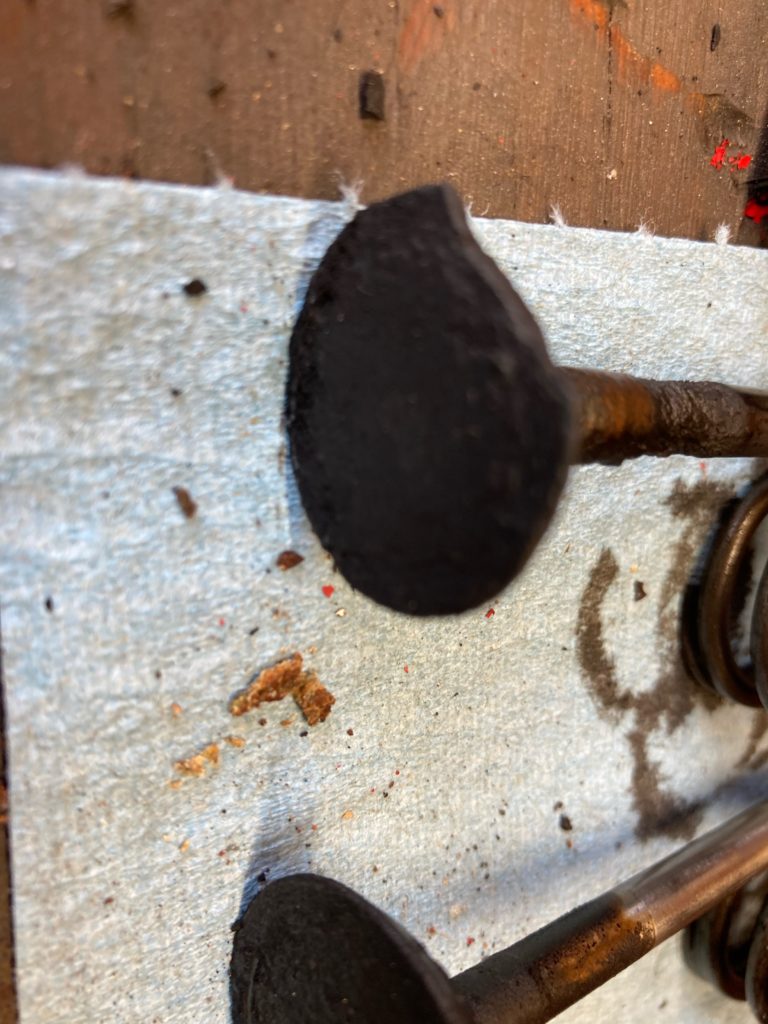
Don and I reviewed the parts manual for our engine, and he made me a long list of parts to order from Westerbeke. The list included replacing all of the valves, not just the broken one.
Two weeks and a thousand bucks later, the parts were in. Don had the engine back together and painted. We started it up, and it ran as good as new. No white smoke. Power to spare.
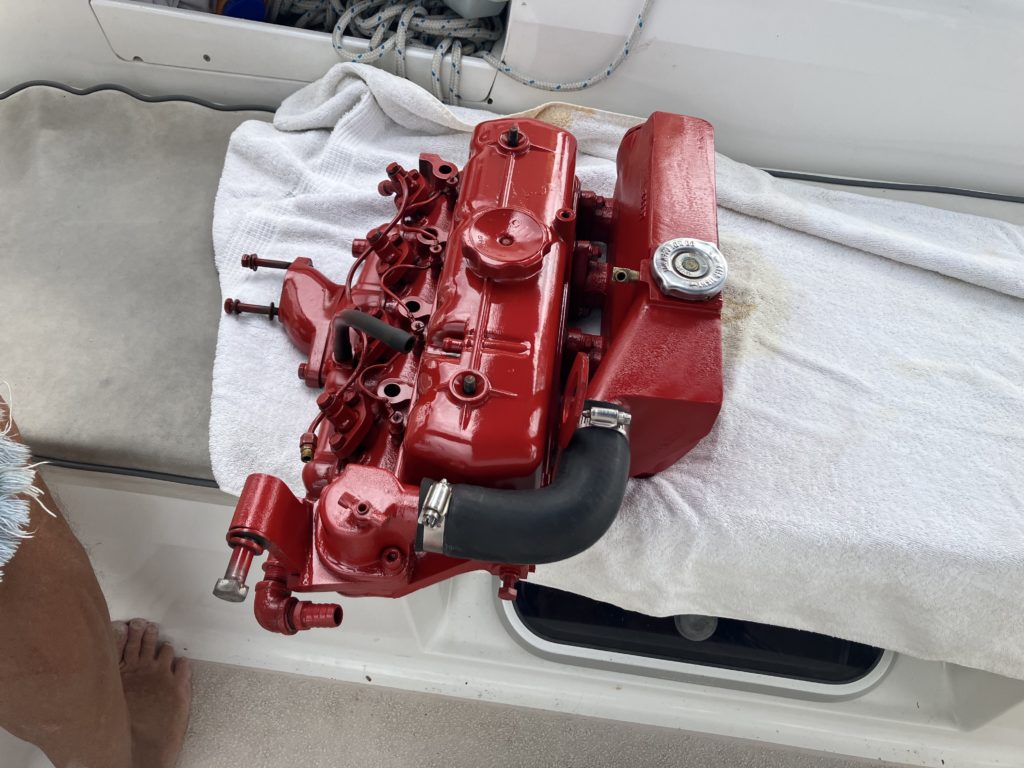

“Are you happy?” asked Don.
“Yes, I’m happy!” I replied.
Beset by Turtles
The turtle lives ‘twixt plated decks
Which practically conceal its sex.
I think it clever of the turtle
In such a fix to be so fertile.– Ogden Nash, “The Turtle”
Our latest outing into the waters around Boot Key took us farther south and west than we had ever been on Catmandu. We left the dock without a clear destination in mind, thinking we would sail west and visit one of two or three anchorages that had been recommended by friends. The original plan was to anchor between the old and new bridges at Bahia Honda, but currents are known to be strong there and we didn’t want to find ourselves pinned against a bridge in the middle of the night if our anchor dragged.
Other suggestions were farther away, and since the wind was so light (4 or 5 kts), we would have to motor all the way back, even if we managed to sail there slowly. So, we backed out of the slip on a fair Friday morning with the idea of sailing around just for fun and anchoring right outside our home harbor. It would give me some practice sailing and anchoring, which we will need for our future expeditions. (Phil doesn’t need practice, but as he puts it, “we are a team.” Winning teams practice.)
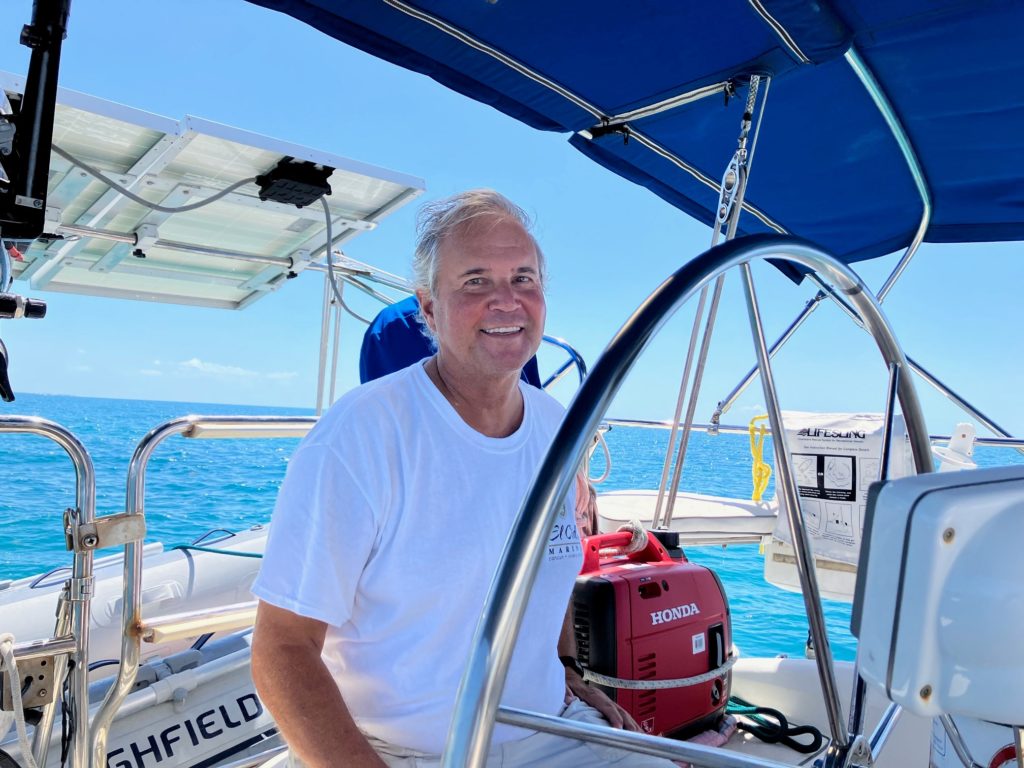
Phil drove out of the channel while I stowed the fenders. As soon as we cleared the markers, Phil went forward to hoist the mainsail. The wind was light and variable, mostly from the east and southeast. I drove in a crooked line, trying to keep the bow into the wind for Phil. After that, we let Otto drive (he seemed to work better than I did). I helped pull out the jib, noting that I forgot to put a stopper knot in the jib sheet (again). Soon we were sailing slowly toward the west, and we cut the engine.
What a difference it makes when the engine goes off. Every sailor loves that moment, when the diesel engine quiets and the wind takes over. We sailed a parallel course to the 7-Mile Bridge and passed the western end. We approached Bahia Honda, headed a little to the south, and kept going. The ocean was nearly flat, and it was a peaceful few hours.
We heard splashes all around us, and saw rings of white foam on the surface of the water. Phil figured out that they were made by turtles, and called them “turtle pops.” Sometimes we caught a glimpse of a turtle’s head, if it stayed up long enough, and sometimes a flipper would fly out. Most of the time they were too fast to see, and all we got was the ring of white foam and a splash. But they were all around us or possibly swimming with us. “We are beset by turtles,” Phil announced.

From the rare parts I could see, we think they were Hawksbill turtles, with a possible Loggerhead or two. The Hawksbill turtles have a distinctive spot pattern on their front flippers, and that is what I used to identify them. Turtles do not stay on the surface for long, and they are pretty quick to dive if they spot a human or a boat. Here is a Hawksbill turtle. They are about three feet long from head to tail.
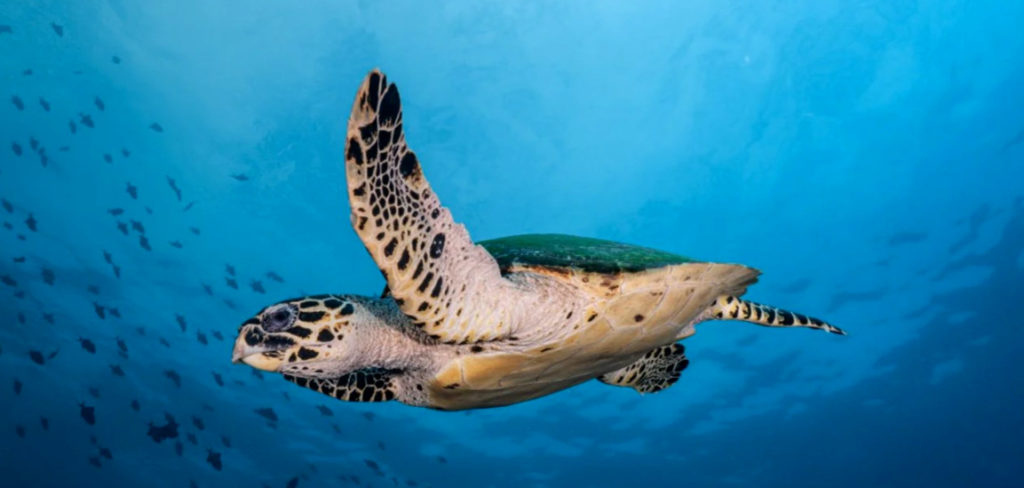
We sailed for a few hours and then turned toward home. The wind was so light, it would have taken us several hours to get to the anchorage, so we had to motor sail. There were only three other boats there, so we had no problem picking out a spot. I drove while Phil dropped the anchor. He had to adjust the clutch on the anchor windlass, so I’m glad he didn’t send me forward to drop the anchor. I do have to practice that at some point.

We knew not to get too close to shore. In light winds, the bugs (no-see-ums) can be brutal. We had some adult beverages, listened to music and watched our old cat Maggie climb the companionway stairs and join us in the cockpit. She rarely comes outside, so it was good to see her making the effort. She took a walk around the deck and settled down beside us. In the distance, we could see a sailboat levitating over the water. Or, atmospheric conditions make it look like that.
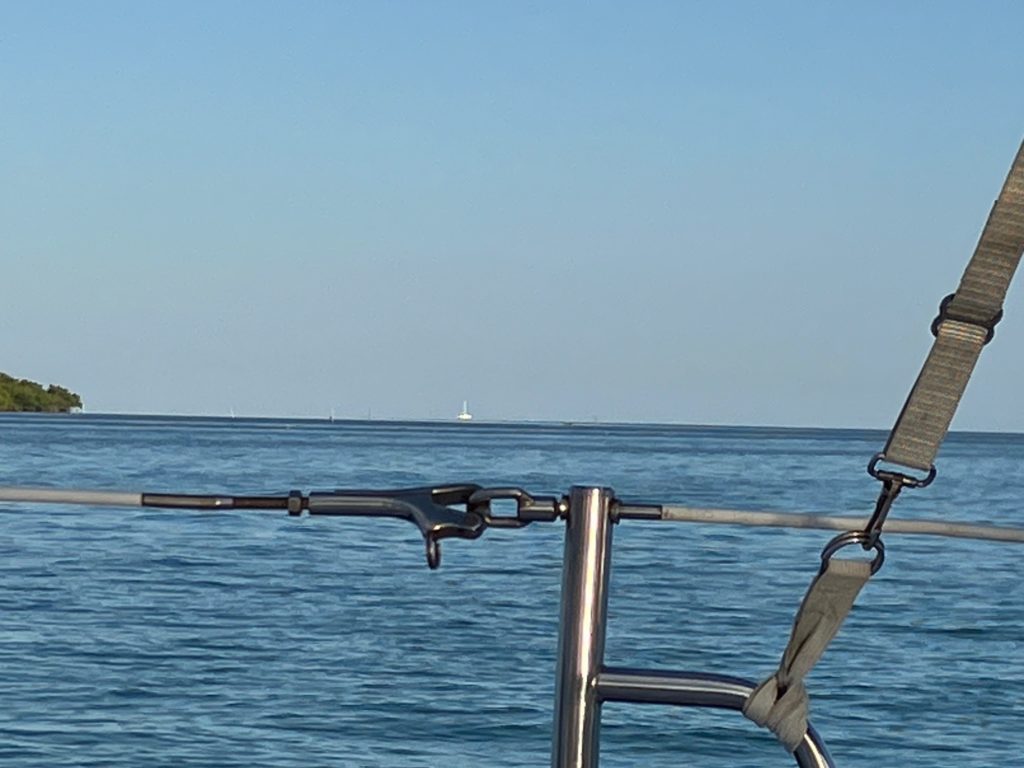
Memorial for Mom
A few months after my mother died, the people at Seasons Hospice who cared for her during her last days gave my sisters and me a memorial lantern. We hadn’t planned a time or place to deploy it, and my sisters expected that I would light it and release it somewhere over the ocean. Phil thought it would be a good time and place to finally send it off. After grilling Impossible® burgers for dinner, we waited in the cockpit for the sun to go down.
My mother and father had a running argument about where to vacation. My dad wanted to go to the woods, and he usually won. But Mom loved the beach. She grew up in Westerly, Rhode Island and her grandfather had a beach house on Misquamicut Beach. She spent her summers there until she was 10, when the Hurricane of ’38 blew the beach house away. It also killed nearly 300 people in Rhode Island that day, including some of my mother’s schoolmates.
There was little left of the house on the beach, just a tiny bit of the cement sea wall. The top floor ended up two miles inland, the bedspreads still dry and folded on the beds. The hurricane did not dampen her desire to spend time at the beach. (It was different for her grandfather. Devastated, he sold the property without ever going back.) When my sisters and I would visit the beach with my mom, we would find that bit of sea wall and lay our towels out beside it.
This made me feel that flying that magical lantern over the ocean would be a fitting way to honor my mother. My sisters live far away, so they would not be able to participate. Phil and I got out the paper lantern kit, and making sure it was environmentally safe and ocean-friendly, we looked for the instructions to light it. Hilarity ensued. Apparently, AI has not advanced sufficiently to translate Chinese into understandable English. Wishing Light Operating Instructions (I am not making this up.):
- After the distribution of fuel to packaging equipment Kong Cross wire in the side of the field again deduction presses the fuel pressure lock firmly.
- A person wishing light take up a Top; another person fuel ignited the four angle.
After cracking up at this bit of nonsense, we figured out how to attach the fuel tile to the wire at the bottom of the lantern, and just after sunset at the anchorage, we tried several times to light it. It was old; it had been on the boat for almost two years, and it just would not light easily. It finally ignited, and we held it up off the deck, fire extinguisher at the ready.
When the “four angle” (the fuel tile was a square) was fully engulfed, the top of the lantern expanded to its full height and started to float away. I’m sorry I don’t have pictures, but it took both of us to hold the lantern and light it safely. I said, “I miss you, Mom,” and Phil let it go into the fading twilight.
We watched it float off the boat for about ten feet and then sink into the sea. We both started laughing, and I knew if my mom were looking on, she would be laughing too. The next day, as we were making our way back to the west to calibrate Otto again, I thought I saw the remnants of our memorial Wishing Light, disintegrating into the ocean as it was meant to do.
***

How does one tie up a blog with so many threads? I try to make each piece a complete tale, wrapping up all the facets in a well-constructed bundle with some kind of conclusion to make it all work, but this one is about a herd of turtles, my mom, and an overnight outing with Phil on our sailboat. A writing friend of mine asked me once if I consciously looked for a common thread to tie the blog together, and I said, “yes, I keep writing until I find it.” But the only thing I can think of to tie this one together is the ocean.
We live on it, my mother loved visiting it, and turtles pop out of it.
“I have been feeling very clearheaded lately and what I want to write about today is the sea. … It is my favorite thing, I think, that I have ever seen. Sometimes I catch myself staring at it and forget my duties. It seems big enough to contain everything anyone could ever feel.”
― Anthony Doerr, All the Light We Cannot See
Running in Circles
When in danger or in doubt, run in circles, scream and shout.
― Herman Wouk
If you were driving east into Marathon last week on the Seven Mile Bridge and looked out on the ocean side, you would have seen a sailboat with no sails up, spinning in place. That was us, going around in circles on a flat, calm sea. I could have called this article “Donuts in the Deep,” “Circling the Drain,” or simply “Calibrating the Compass,” but I was trying to imagine what people would think as they drove by and spotted a sailboat slowly rotating.
Our auto-pilot had stopped working on our way to Marathon last August, and although Phil had replaced the rudder reference (what’s that? see photos), the direction of travel was still about 50 degrees off, so we knew the compass had to be calibrated. For months, it was on the “to-fix” list, but since the engine was blowing white smoke and losing power, it wasn’t our first priority. It took many months (on island time) but finally, the old Westerbeke was patched up, fitted with all new valves and a new head gasket, and ran like a top. It was time for a shake-down cruise.
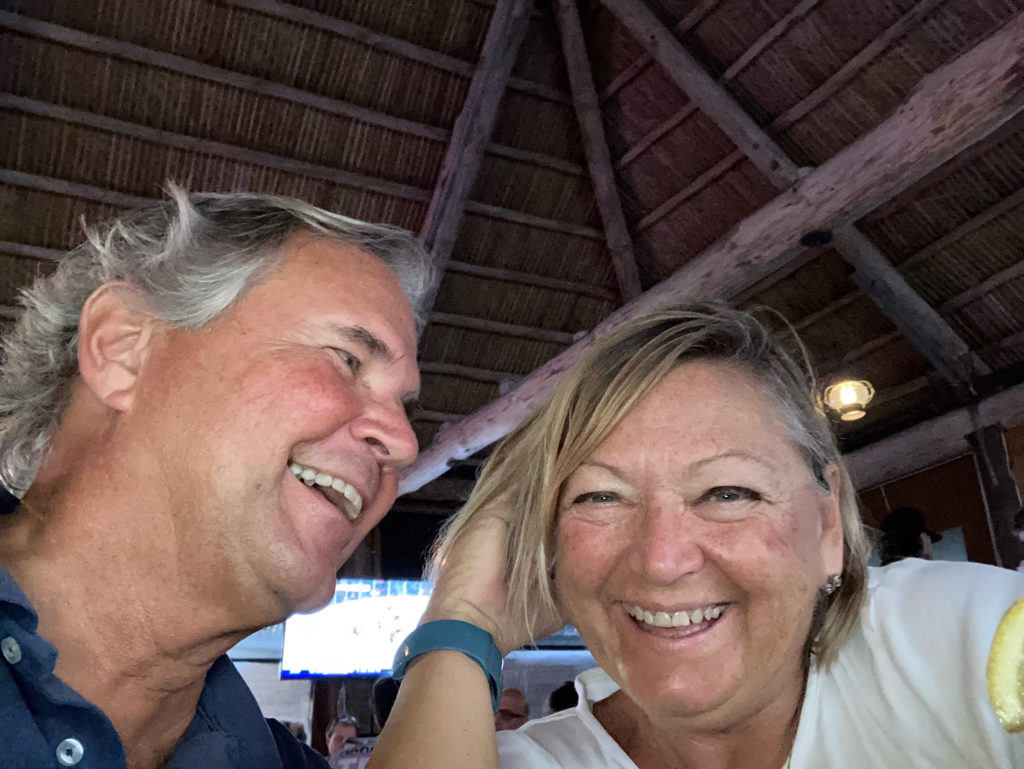
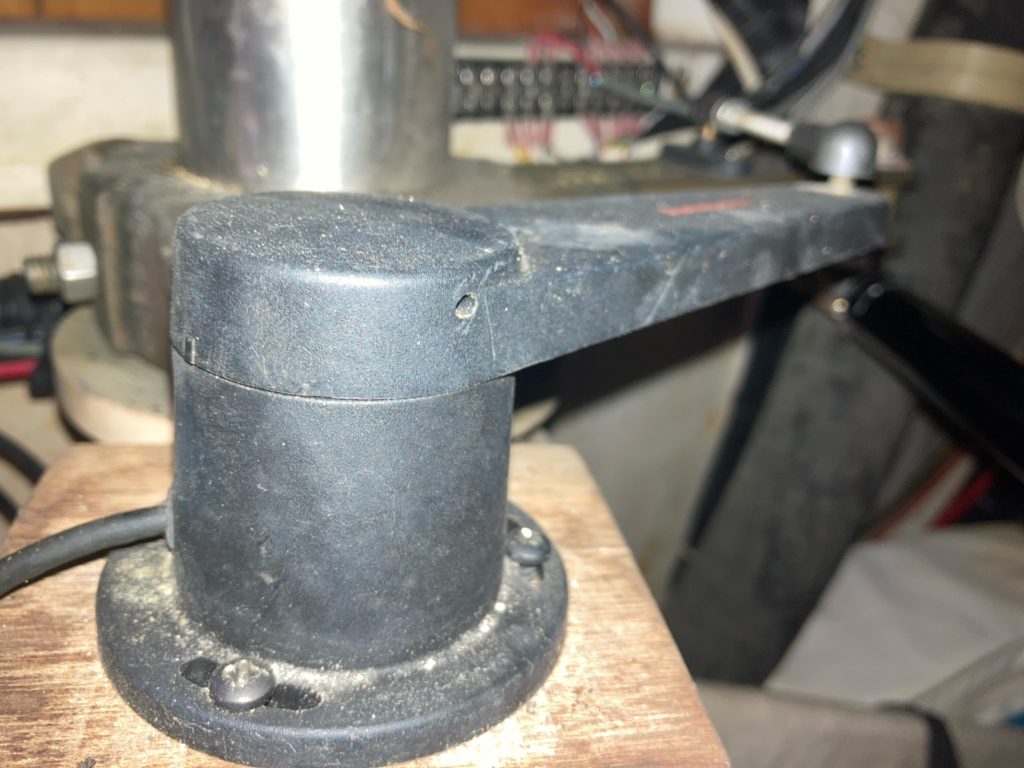
We picked a calm day that promised light winds. After going through the cabins and salon and putting away everything that could go flying, we were ready to leave the dock. You wouldn’t believe the loose items we had accumulated in seven months. We had grocery bags full of loose breakables secured in the v-berth. I tied up the drawers in my mom’s jewelry box – that was a disaster the last time we sailed in rougher waters; the drawers came out and scattered earrings and necklaces all over the captain’s cabin. I locked cupboard doors, secured the cat food and water dish, and took everything off the galley counters. As it turned out, we probably didn’t have to do all that. I probably didn’t need my seasickness relief band, either.
No neighbors were around that Wednesday morning, so Phil and I unhooked our electric cord and took down the dock lines. Without a breath of wind, Phil backed out of the slip easily and we were on our way. I lifted the fenders and Phil hooked up the lifelines. It was partly cloudy, not a beautiful day, but not hot. The purring of the engine was music to our ears.
We have an 18 ½ year old cat who doesn’t like to travel much. No purring was heard from the cat quarters. Maggie hunkered down underneath the salon table, threw up, and went into the head to lie on the floor. She got extra treats when we got home.
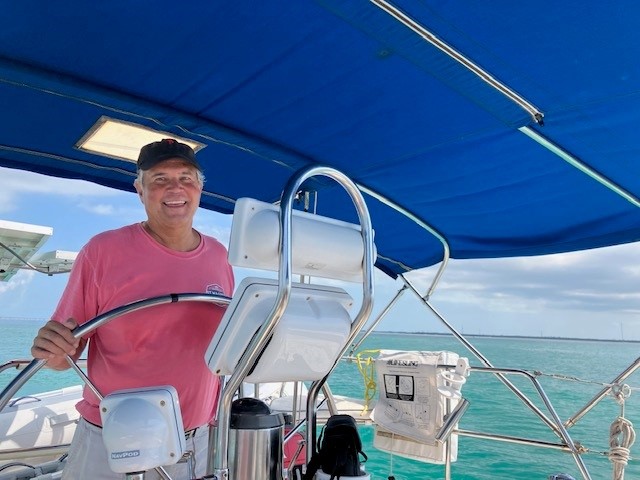
We exited through the channel and headed west toward deeper water. The ocean was flat calm and the engine sounded healthy and happy for the first time in a year. Phil followed the instructions for calibrating the flexgate compass, pressing a series of keys on the autopilot controller. Then, when the screen said, “Turn boat,” he slowly rotated Catmandu while I thought about how comical it must look from the bridge.
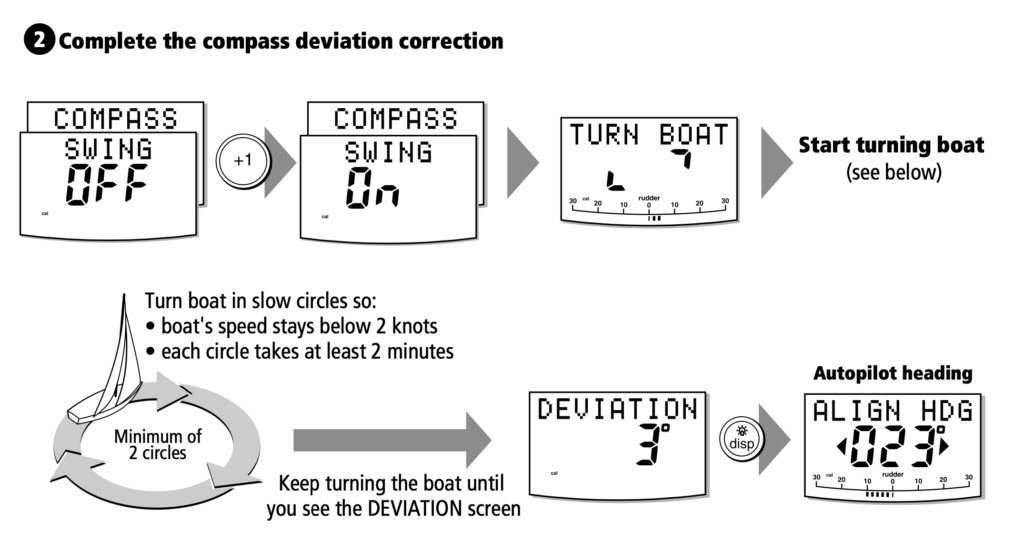
We made two or three revolutions before the message told us how many degrees of compass deviation we had so we could adjust it to our actual course heading. Done! Our autopilot is fixed. For those who don’t sail, this device allows us to set a course, set the sails or run the engine, and relax while “Otto” steers. (Yes, it reminds me of the inflatable pilot in the Airplane movies.)
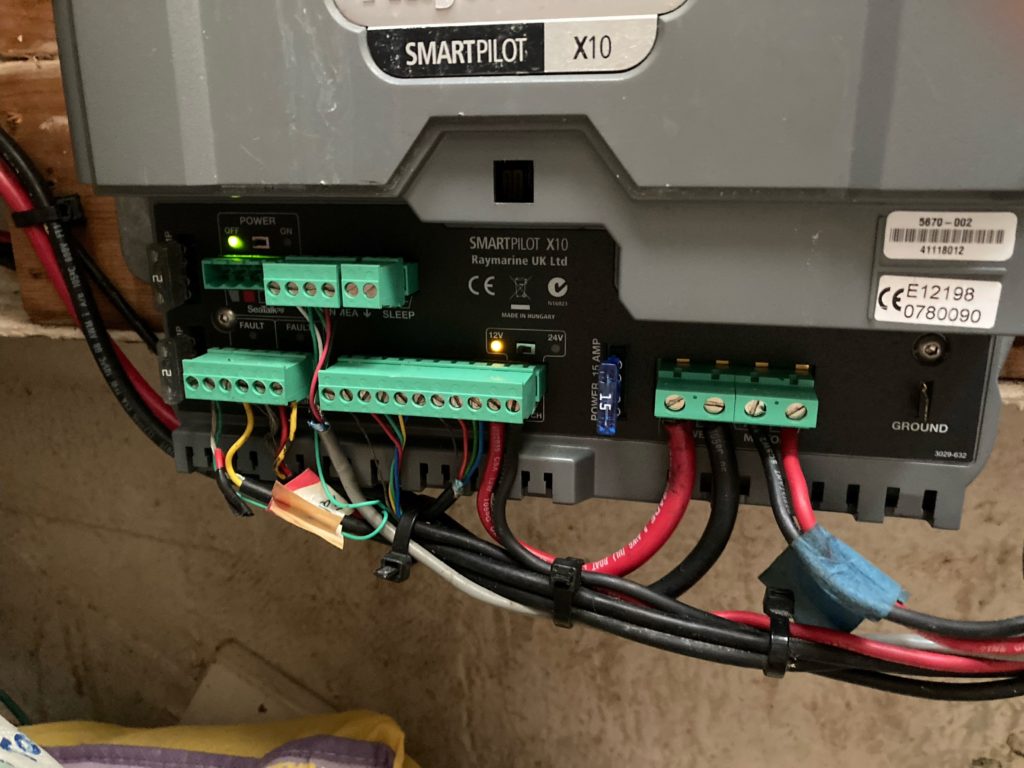
We were not ready to head back to port, so we pointed into the wind, raised the head sail and turned off the engine. It wasn’t worth raising the mainsail; there was almost no wind. We bobbed around in the water, loving the peace that descends when the engine turns off. The breeze was no more than a light caress on the jib, and we managed to move about a half mile at .5 knots. But we were off the dock. We were sailing.
Dolphins appeared off the port stern, and we heard one just behind us slapping his tail. There were several more off the port bow, swimming so close we could see them under the water. They slap their tails to stun fish and to tell their pod members where the fish are. They swam around us for a while, and after they disappeared, we spotted a large sea turtle with a patch of seaweed on his shell. The turtle wasn’t close enough to identify the species. He dove back under the water, and we turned for home.
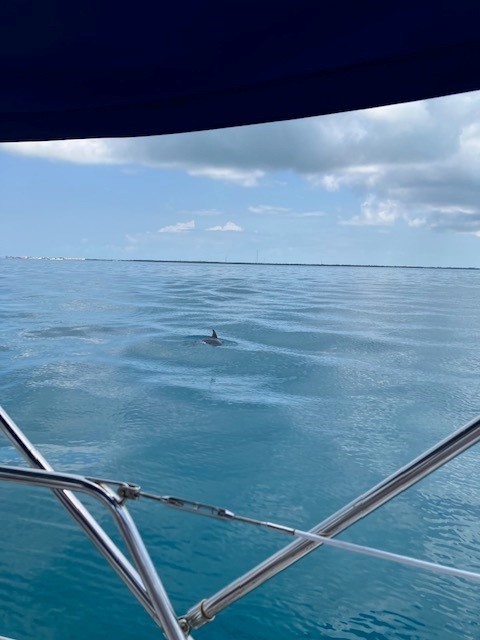
Where are we from, and where are we going?
Our slow cruise began nearly ten years ago in Annapolis. Now it can continue. We have a working engine, an autopilot, a new water maker, and updated charts. We have the means to visit Key West, the Dry Tortugas, the west coast of Florida, the Bahamas and beyond. But hurricane season approaches, and we will have to be somewhere safe until November. We have been here in Marathon for almost a year, loving the climate-controlled pool, the easy access to laundry and supplies, and the incomparable sunsets. We travel by dinghy to restaurants and tiki bars – and back. Maybe we are a bit spoiled, for cruisers.

Living the island life just south of mainland Florida, we find ourselves in the company of other boat-dwellers, sailors, and wanderers. Phil makes friends easily, and we socialize at the pool and the marina parties, only to discover weeks later that our new friends have moved on. Most people are just passing through, but we have been here so long, we got a 10% discount on dinner the other night for being “locals.”
It is a welcoming community, and when they ask us where we are from, we look at each other for an answer.
“All over,” I say. Born in California, raised in a nomadic military family in communities on both U.S. coasts, eventually landing for a time in Colorado, Washington State, and New Hampshire, I never know what to say.
“Where’s home, though?” they might ask.
“Wherever the boat is,” says Phil.
We don’t know exactly where we are going next, and we don’t know when. But we do know we can find our way there with a working autopilot, a working engine, and a correctly calibrated compass. Until we have a float plan, a destination or at least a route on the chart plotter, I guess we will be running in circles. At least we are finally running.
Servicing the Electric Anchor Windlass … Sort of!
Phil here, with a tech update on servicing and maintaining our Catalina 380, 38-foot sailboat. Boats of our size and larger have anchors that weigh on the order of 35 pounds and above, and have anchor rodes (i.e. lines) that are all chain. They are heavy. Thanks to gravity, anchors and chains are usually easy to deploy. However, it is difficult to retrieve them when it is time to pick up the anchor and sail away. That is where the electric windlass comes in.
Catmandu came with a very nice Maxwell Freedom 800 electric windlass, that has worked flawlessly for the past three years. However, last July when Kay and I were testing the boat’s systems at the dock in preparation for sailing south, the anchor windlass would. not. deploy.
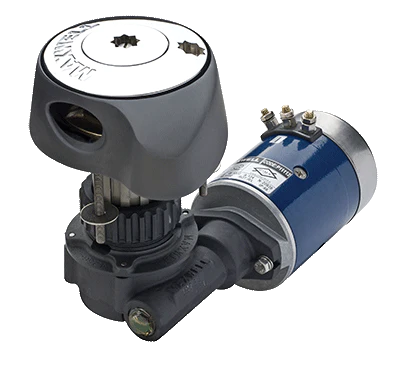
We contacted our dear friend Mike Dillon, an engineer for Maxwell in Fort Lauderdale, for help. A new windlass costs about $2000, and I hoped we could repair ours instead of replacing it.
“When did you last service the windlass?” Mike asked when he came aboard with his bag of tools.
“You have to service anchor windlasses?” I replied. I had no idea. I thought they were magical devices that just worked for years when you pushed the buttons. They have shiny, stainless steel turny things on top and magical whirring things that are invisible below the deck.
It turns out you have to service anchor windlasses periodically. #Sad. It appeared that the windlass had not been serviced in over 20 years. Mike took apart the top part of the windlass and found that the two clutch halves had seized together, and that had prevented the anchor chain from deploying. We pried them apart with hand tools and brute force, cleaned out some embedded dirt, and greased the clutch. Then the anchor and chain deployed normally once again. Note to self: the user manual says the clutch has to be greased every year or bad things can happen.
Mike opened an access panel below deck and inspected the gearbox and electric motor. The gear box was empty when it should have been at least half full of 90 weight gear oil. All the oil had leaked out. Left empty, the gears would have eventually ground each other to dust and the windlass would be ruined. Mike was able to throw some regular oil into the gearbox so that we could get underway, and it was good enough for our cruise from Hollywood to Marathon.
Change the scene to the present day. Catmandu has been at a slip in Marathon for seven months, and properly servicing the anchor windlass has finally come to the top of the to-do list. Servicing involves greasing the clutch, removing the gear box, replacing all the oil seals, and replacing the gear oil. I was able to grease the clutch again. I even installed a “pressure arm” that presses the anchor chain against the chain wheel of the windlass since it was missing on my unit. However, after accessing the rest of the windlass below deck, the gear box would not come off. It had seized to the shaft and I could not get it off, even after applying penetrating oil daily, banging on it with a hammer, and applying heat from a heat gun.
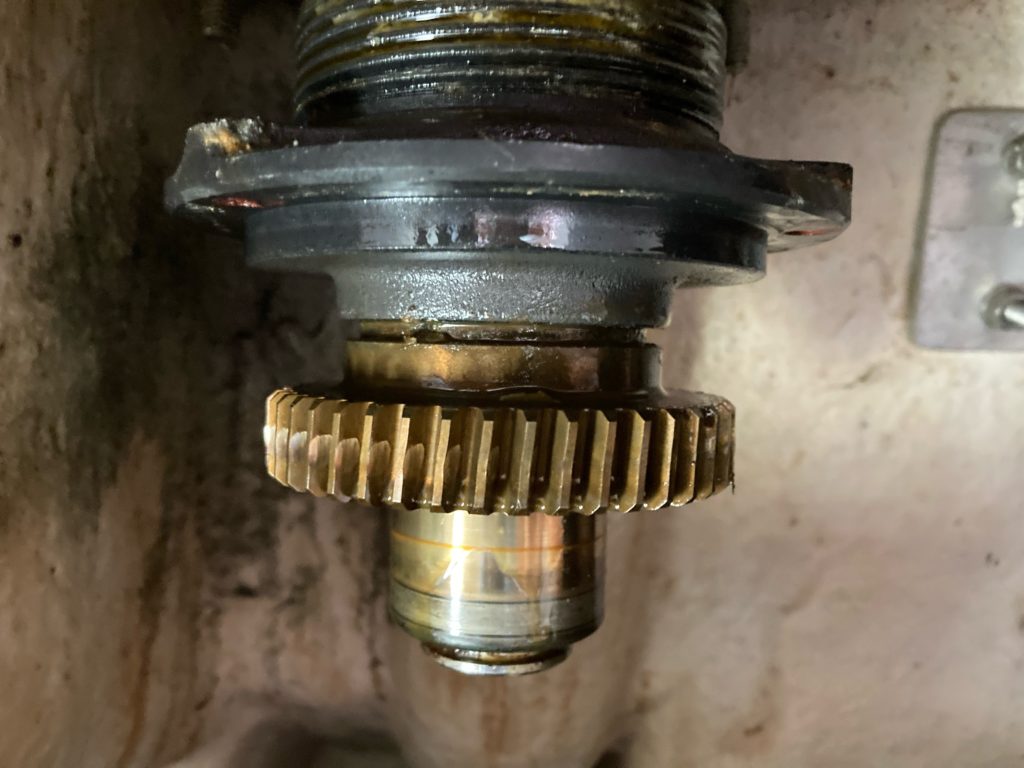
The next best thing was to merely remove the bottom part of the gear box and the electric motor from the assembly while leaving the worm wheel and gear box cover on the shaft, as seen in the photo above. As you can see below, out of oil again.
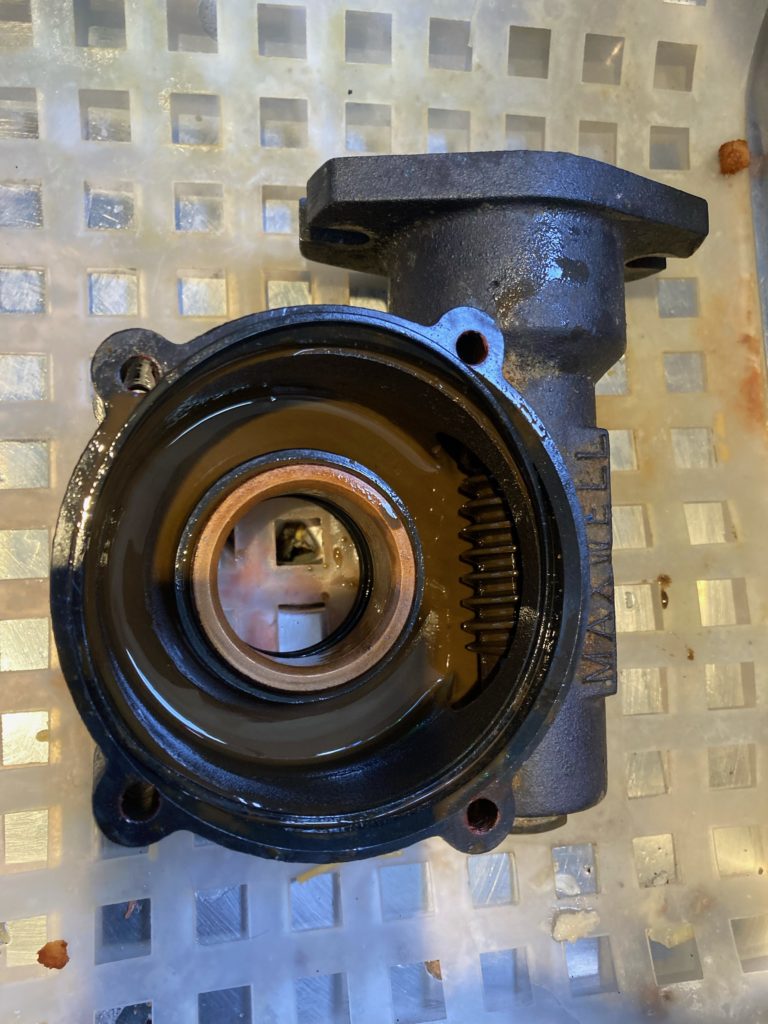
Then I turned the gearbox to the side, and identified an oil leak past one of the oil seals. Oil seals are partly rubber and partly metal, and must seal the gearbox and shaft precisely in order to keep the oil in.

I bought a Maxwell rebuild kit for this windlass, which includes replacement oil seals, clips, o-rings, and a sight glass for the gear oil. I was able to get all the old seals out and replace them, except for the seal in the gearbox cover. Of course, there is a YouTube video for that.

I installed the new hardware and bolted the gearbox assembly back onto the windlass with fresh 90 weight gear oil. After applying anti-seize compound to the bolts, I secured the gearbox to the shaft and re-installed the electric motor.
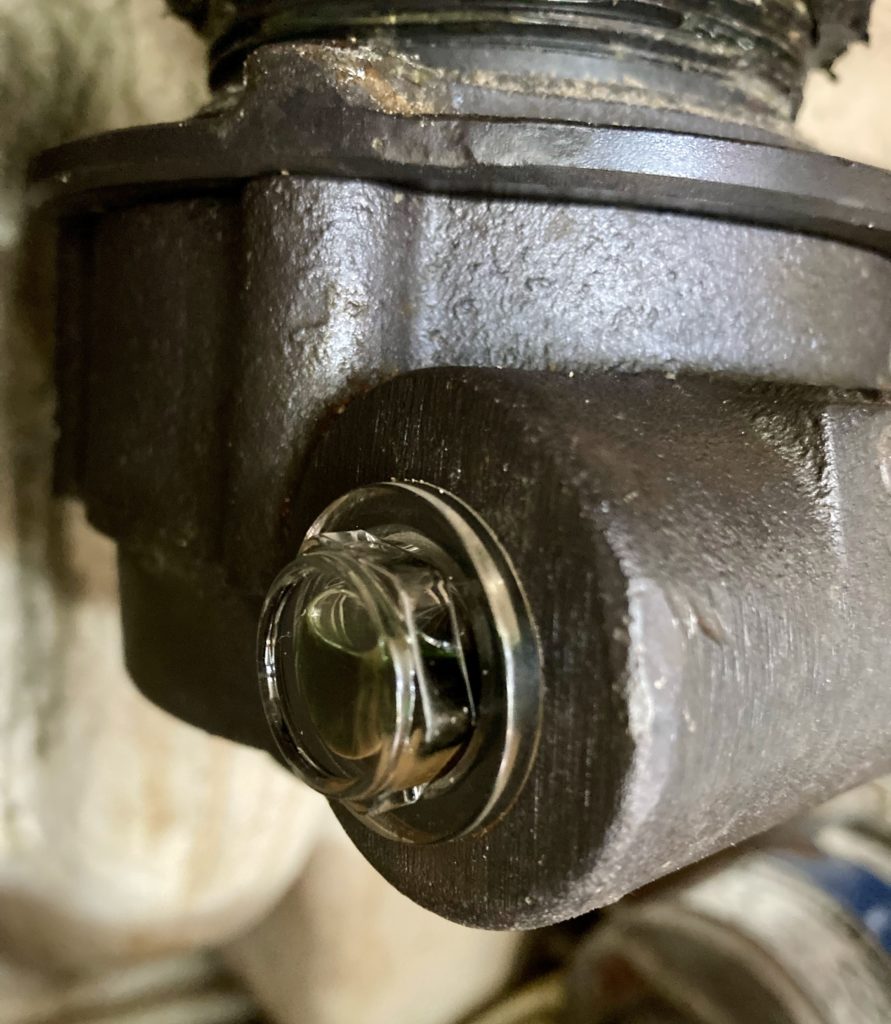
To prove it works, I ran the anchor up and down at the dock a few times, and called it a success. Now, the anchor windlass has been completely serviced — except for greasing the worm wheel on the shaft and replacing the oil seal on the gearbox housing. Good enough, as long as they never have to come off.
Wildlife
“In every walk with Nature one receives far more than he seeks.”
― John Muir, Naturalist
“Sometimes I need only to stand wherever I am to be blessed.”
― Mary Oliver, Poet
In The Other, a 1971 novel by author Thomas Tryon, a pair of twin boys learn a game from their grandmother, and even though the novel goes to a very dark place, I love that game. I’ve remembered it through all of these years and practice it often. It goes like this: you stare at some living thing for a long time and imagine that you can see what it sees and feel what it feels. If it’s a bird, you can experience flying and feel the wind in your feathers, feel the drafts lifting you up by the wings, imagine how it feels to swoop out over the water and soar on the breeze. In the novel, the boys practice on each other and it doesn’t end well. But try it sometime. Pick a seagull or a pelican and take it for a spin.

Birds
Being retired, I feel that it is finally okay to spend time bird watching. It’s probably not okay to spend time imagining that I’m a bird, but the mind wanders and that’s what happens. From the cockpit of my boat, I can see seagulls, ibises, pelicans, cormorants, egrets, ospreys, and anhingas – sometimes all at once sitting on a large piece of debris in the harbor. They all sit together as if they are one flock. Birds have rules, usually. One bird to a piling, and only one. But a line of different species crowds together on the rusting train car, squawking and fussing.

Pelicans: My favorites are the pelicans. They are huge, with brown bodies and white heads folded down into their necks. In the air, they soar without flapping, graceful as scarves on the wind. But when they spy a fish in the water to capture and store in their massive throats, they become clumsy bundles of feathers, feet and beaks, crashing headlong into the water with a messy splash. It takes them a second to straighten out their limbs, toss the fish into their expandable throats and sit quietly, composing themselves. I’m going to make a slow-motion video of the pelican plunge and set it to the sound of a World War II bomber plane. These antics make me laugh out loud sometimes.
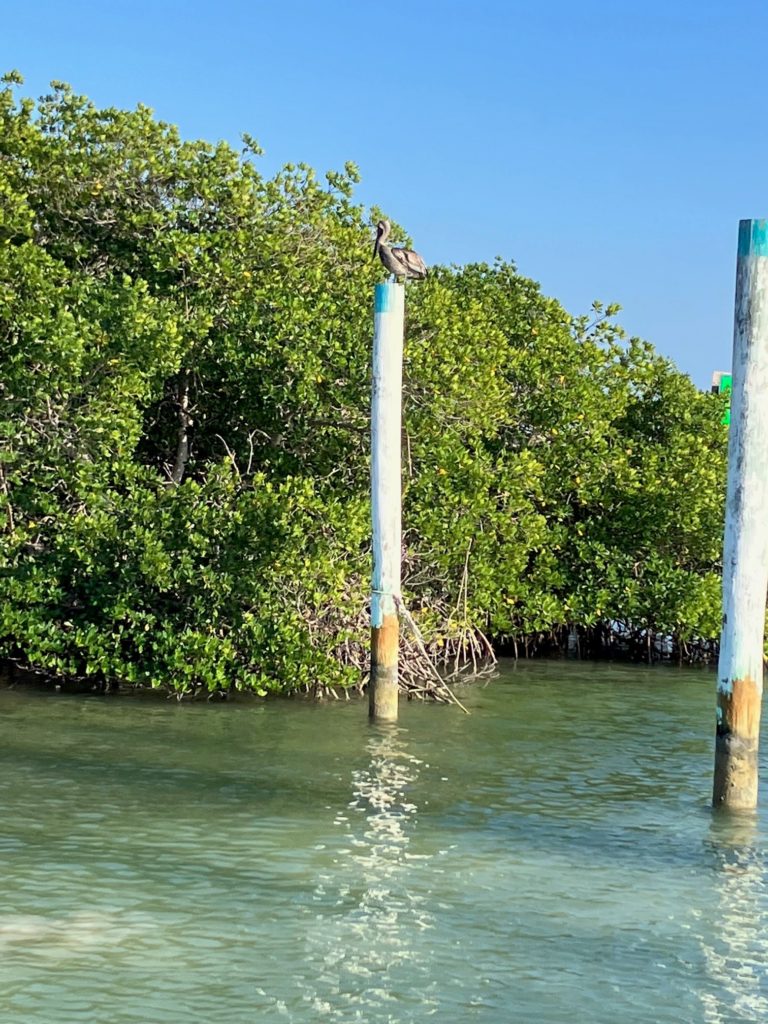
Ibises: These social birds fly together to a designated tree on land right at sunset. We’ve seen it again and again; they gather in the branches and rest there overnight. The coordinated timing is remarkable. They all seem to know when it’s time to go. White ibises have bodies shaped like footballs and long, pink curved beaks, although the beaks are straight until juveniles reach adulthood. These birds are the playboys of the bird kingdom. Males have multiple girlfriends, and mate often with a variety of females. However, a male will build a nest for one particular female and defend it while they raise their chicks.
Anhingas and Cormorants: These birds look very similar in the water. They swim around in a “seated” position, low in the water with just their heads and necks sticking out. They are similar in size, and both birds tend to sit on a perch with their wings unfurled. They don’t have oil glands like other sea birds, so they dry their wings by hanging them out. The lack of oil is an advantage in making deep dives for fish. Anhingas have pointed beaks and seem to be wearing snazzy silver jackets, while cormorants have hooked beaks and wear basic black.
Egrets and Herons: My father was proud of being able to identify birds by their minor characteristics. My sisters and I would tease him by asking what color the bird’s eyelashes were, or how many toenails they had. I guess I have come full circle: I know the difference between great egrets and great (white) herons is in their leg color. The white phase of the great blue heron is found only in Florida and has light colored legs. The great white egret has black legs. We have both here in Marathon, and we have some cranes that also look similar. They are tall, graceful, majestic. They can stand perfectly still on one leg in the shadow of the mangroves as we drift by in the dinghy.
I’m not very good at identifying the birds; I have a brother-in-law who can tell you what bird it is if you just send him a picture. But these are my few favorites, and I do love to waste my time watching them.
Marine mammals
Manatees: There are manatees at the marina for the winter. We are warned not to feed them or provide fresh water (you should see them lap up the freshwater leaks, as if the water they live in is too salty for their taste). Manatees are huge blobs of elephant-gray blubber, sometimes eight or nine feet long. They are shaped like giant loaves of Phil’s French bread, adding a flat tail, fins for front legs and a pig-like snout. When you see one in the water, it looks like an oval hump of seaweed until it raises its nose to breathe. In spite of this ugly description, manatees are actually cute. They have adorable faces.
These water-logged blimps are also mysterious and shy. We know they are here, but no one knows how many there are, and they’re nearly invisible when they hang out at the bottom of the harbor. Is that a rock, a seaweed pile, or a manatee? One day, a large adult floated for hours near the back of our boat, and we were convinced it was dying. It moved very little except to breathe. Our next-door neighbor, an ER physician, told us it was normal manatee behavior, related to mating. I guess they play easy to get, just waiting for a suitor to wander by.
Dolphins: When the dolphins come, they stay for a while. They never come alone, but in groups of two, three, sometimes five. They slide through the water in graceful arcs, silent and dignified. We have seen one or two fly completely out of the water in a frenzy, but that is rare. Mostly, they travel from south to north in our harbor, showing their dorsal fins every 30 feet or so. Twenty minutes later, they are gone, and I feel fortunate to have seen them.
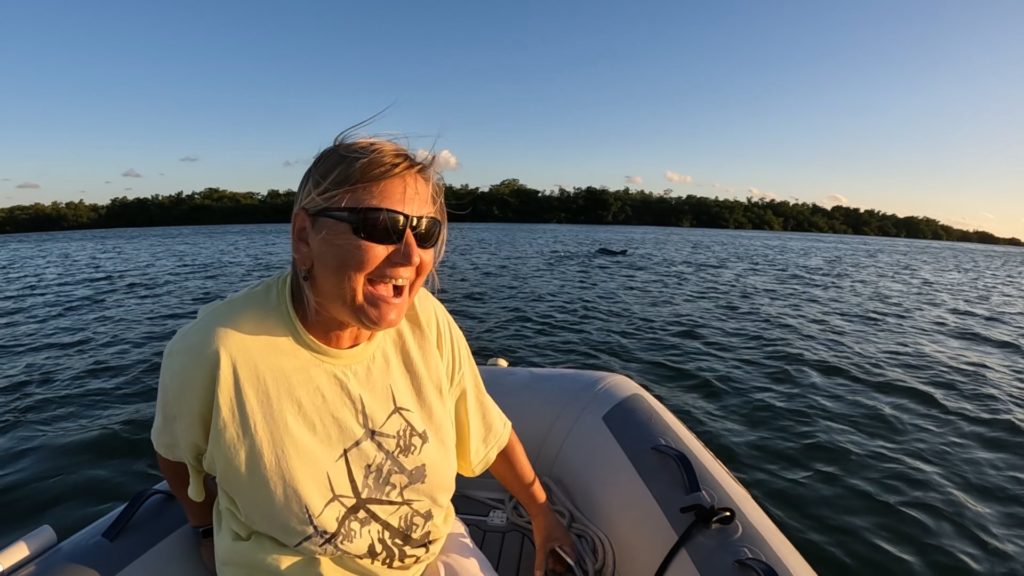
I don’t know why people love the dolphins so much. People gather on the railing of the dockside restaurants to point them out, and the kayakers rush over to get a closer look. As far as I’m concerned, they are royalty – the lions of the ocean – honoring us with their presence. I know when I’ve been blessed.
How to Be Happy
For twenty years or more I’ve been trying to write an article titled, “How to Be Happy.” I may finish it one day, and I think I’ll put something in there about hanging around in nature. My happiest times in childhood were spent wandering through the woods in Connecticut and in California. Getting up early to catch rabbits in the backyard or deer next to our campsite brought enormous surges of joy. Sadness has no place in the woods. The birds won’t let it rest there.
So it’s not surprising that I spend time looking for wildlife in the Keys. It’s a different kind of wilderness here than I am used to, but the expanse of water just past the cockpit, the shadowy green of mangroves on either side of the harbor, the amazing oranges and fuschias of the always spectacular sunsets; they call to me. There is a lot to learn under the water and in the salty creeks where turtles and iguanas hang off the low branches. There are tiny deer in the islands to the west that I have never seen. I have a lot to do.
It’s just past five now, time for the ibises to be gathering and flying off toward land. There’s a small manatee next door. We just saw him poke his snout up to drink fresh-water drips from the boat in the next slip. Maybe later there will be dolphins.
“This grand show is eternal. It is always sunrise somewhere; the dew is never all dried at once; a shower is forever falling; vapor is ever rising. Eternal sunrise, eternal sunset, eternal dawn and gloaming, on sea and continents and islands, each in its turn, as the round earth rolls.”
― John Muir, “John of the Mountains,” American Naturalist and Environmental Philosopher
And Then Came Ian
The fishermen know that the sea is dangerous and the storm terrible, but they have never found these dangers sufficient reason for remaining ashore.
– Vincent Van Gogh
When you walk through a storm, hold your head up high and don’t be afraid of the dark.
At the end of a storm, there’s a golden sky and the sweet silver song of a lark.
– “You’ll Never Walk Alone,” by Rogers and Hammerstein, Carousel
The storm was supposed to be called Hermine, but a swift upstart came racing off the coast of Africa behind it and took the name away to sea. So, then came Ian. It was a slow mover, keeping a steady pace across the Atlantic as Storm 9 until it finally earned a name as it reached the Caribbean. “Waiting for a hurricane is like being stalked by a turtle,” a friend posted on Facebook. We didn’t think Ian was coming for us.
The track was uncertain, but the tropical storm went south of Puerto Rico and made for the Western Caribbean. Like many others before it, Ian could gain strength in the warm waters of the Gulf and head toward the shoreline of Louisiana. Poor New Orleans! I really thought that’s where it would go. Local knowledge tells us that if a storm passes south of Puerto Rico, it won’t threaten southern Florida. Ominously, another storm in 2004 – named Charley – also passed south of Puerto Rico and did a lot of damage in southwestern Florida.
Friday, Sept. 23: The spaghetti models (those stringy looking storm track predictions) were promising a turn to the north across the island of Cuba and then an easterly turn toward the west coast of Florida. It wobbled to the west, giving us a little relief. But we were concerned about high winds and began preparations. The marina office told us we can move to a larger slip, to give the boat room to bob around. We made a list of high-wind preparations. Luckily, we had friends coming to visit who had lots of sailing experience and we listened carefully to their advice.
Saturday, Sept. 24: With our friends’ help, we removed the head sail and stowed it inside. Then we moved Catmandu to the larger slip, so the boat was now facing west. Since the storm would pass to our west, that seemed the most likely wind direction. This proved to be wrong, but the decision to move was definitely right.
We were able to double our lines, add more lines to the midship cleats, and put spring lines on both sides to keep the boat loosely in place. Too tight, the lines or cleats could break; too loose, we could bounce off the concrete dock or the wooden pilings. Phil went to WestMarine to buy new lines and found the stock was greatly diminished – no surprise. He came back with two new lines, shorter than we wanted, at a cost of $190.
Although we thought the storm would bring high wind and waves from the west, we didn’t base our preparations on that fact. We were looking at a long fetch in that direction, which means a great expanse of water loomed with no obstructions. Beyond the mouth of Boot Key Harbor, there is Hawk Channel with its shallow coral reef, and beyond that, nothing but Cuba to the south and a few islands to the west.
It is best to shelter from the fetch, and some sailboats in the harbor began to leave for the Shark and Little Shark Rivers, up around the south coast of Florida and into the Everglades. The eventual path of the storm put these boats closer to the eye, but they tucked into the mangroves and remained until Ian passed. They all made it with little to no damage. The natural protection of the narrow river and dense mangrove trees made this a nice hurricane hideout.
Sunday, Sept. 25: We watched the forecasts every three hours. On the day the storm was forecast to pass closest to us (Tuesday), there was a 20-30% chance of 34-knot winds, and a 5-10% chance of 50-knot winds. In our location, there were no hurricane watches or warnings because the wind has to be 65 knots or greater to be a hurricane (75 mph). (Phil has a way of explaining watches and warnings: Taco Watch – We have the ingredients for tacos. Taco Warning – We are having tacos.)
We were never advised by authorities that we should evacuate. At this point, we knew it would not be a direct hit. In fact, we were out of the cone altogether: No tacos. So we wrapped the main sail, lifted the dinghy from the water and secured the outboard on the back of the boat. We took everything that could fly and secured it inside. We left the dodger and bimini up, a decision we questioned later. (For non-sailors, these are the canvas coverings over the back of the boat.)
Then, Ian shifted slightly. Fed by warm ocean waters, it became larger and stronger. It moved closer.
Monday, Sept. 26: By Monday, the wind was making an eerie whirring sound above the marina, and small rain showers passed through. The rain bands from Ian were approaching, even though the eye was still 200 miles away. We spent the day getting ready: tying down the solar panels, securing the cockpit table, strapping in the dinghy. Ian was moving slowly across the tip of western Cuba.
At 6 p.m., the air conditioner stopped working. It wasn’t the storm at all, just a reminder that a boat will present problems no matter what else is going on. The inlet through-hull was clogged. As Phil tried to unplug it, the plumber’s snake broke. We headed to Home Depot. Phil bought a new snake and a little plastic drain cleaning tool ($3) that busted up the clog.
As soon as we got the AC running, I started closing the hatches. There was a scary sound of distant thunder. I was reaching up to close a hatch when we simultaneously saw a brilliant flash and heard a deafening crack. I ducked and screamed but was not hit. Phil and I looked at each other. “That was close,” I said.
“Right here,” he said. We found out later that lightning had hit the boatyard less than a quarter mile away and knocked out the Wi-Fi signal. (A week later, it still has not been repaired.) Lightning is a danger to boats with tall masts. Phil says he relies on the “buddy system,” which means positioning next to taller boats. The wind kicked up in the middle of the night and Phil went outside to loosen some of the lines and alleviate the banging. The boat was straining all the dock lines, but the wind was primarily from the southeast. The dinghy was swinging against the stern, making a lot of noise. Sleep was difficult.
Tuesday, Sept. 27: I confess to Phil that I am having trouble writing this blog. It should have been done days ago – and it’s getting so long.
“I know how it should start,” he said.
“How?”
“It was a dark and stormy night…”
It started with a tornado watch, and then a warning. We are having tacos. I’ve always wanted to see a waterspout, but only from a distance. Tornado warnings are scary, to be sure. At 9 am, the winds were only at 12 knots but it was dark and stormy. People were starting to come out on the docks, checking lines and making last minute adjustments. We loosened the lines on the dock side to give Catmandu room to move around without hitting. Rain came in small squalls all morning and the wind started to build. By afternoon, we could no longer get off the boat. We turned on the wind instrument and saw gusts of 28 knots. I took a picture of a palm tree. Looking at that, I can hardly imagine what 120 knots would look like.
Tuesday afternoon, we started rolling and heeling to the starboard side. The winds were roaring, and they made a flute-like sound going across the masts and shrouds in the marina. Outside, it was impossible to talk over the higher gusts, which were now in the upper 30s. The palm trees were all fanned out to one side. When the storm track shifted slightly to the east, it brought our location to the very edge of the tropical storm force winds. Farther up the west coast, Fort Myers was getting ready for a direct hit. Ian passed Key West and stirred up 25-foot waves in its wake.
Phil doubled the port stern line and backed it up by winding the end around the winch. The cat curled up under the table, a spot she claims whenever the boat moves around too much. By suppertime, we were rolling around so much, I had to release the gimble on the stove. This allows the stove to swing, keeping it level. We were tied to a cement dock, but bobbing around as if we were in open ocean.
The wind rattled the aluminum frame that holds the bimini, making the boat sound like it was coming apart. As evening fell, we looked at each other every time a sustained gust leaned the boat to 20 degrees or more. The winds were beating on the port stern, kicking us in the butt. The poor dinghy was swinging around like a balloon on a string.
Since the wi-fi was still out, we decided to watch a movie. I guess it was a strange choice, being on a boat in a storm, but we watched The Abyss on DVD. The winds were getting stronger outside, and we started getting periods of pelting rain. Phil put towels in the aft cabin where rain comes in to prevent wet pillows on the bed. But we weren’t sleeping. The boat was moving around so much, our Fitbits were registering steps. I was waiting for dock lines to snap and throw us against the pilings, or worse.
After the movie, we went outside with flashlights to check the lines, and all were holding despite the onslaught. We checked the wind speed and found sustained winds of 30 knots with occasional gusts up to 55, more than gale force. (We found out later that gusts of 67 knots had come through Boot Key Harbor. Hurricane force is 65.)
Looking out into the wild night, I imagine being a primitive human, with no knowledge of weather and no advance warning for storms. In that mindset, with this kind of fury, of course I would believe the gods were mad at us. There could be no other explanation.
Wednesday, Sept. 28: After a long night, we heard a lone voice on the VHF radio. “Okay,” he said, “I’ve had enough of this!” We could not pull the boat to the dock to get off, the wind was still so strong. Phil hooked a dock line to one of our winches and used that to pull the boat close enough for him to jump to the dock. I wasn’t going to try it. He took a picture of the boat, noting the weird color of the water. It looked like pale blue milk. It was so full of sand and silt it had become opaque.
Elsewhere, Ian was churning toward the west coast of Florida and gaining strength. The Waffle Houses closed – a Florida signal that something terrible was coming. We were starting to relax a little and felt renewed sympathy for those in the path of the storm. We had made it, but not without damage. The solar panels had somehow rotated to an unnatural position, and at first we couldn’t figure out how that happened with the outboard motor in the way. Then Phil discovered the dinghy davits (the stainless steel racks that hold the inflatable boat up) were bent. Yes, the winds had bent steel.
Aftermath: I love storms. I love watching lightning in distant rain clouds, especially over the water. A gentle wind can stir up emotions and memories along with the rustling of the palms. I’m the last one to take shelter when the first drops of rain fall. Now that this storm has passed, even after witnessing the fury of the wind, I don’t love storms any less. I will still marvel at thunderheads, feel the thrill of lightning strikes reflected in the ocean, still watch the horizon for waterspouts. But I will think twice about being on a sailboat within two hundred miles of a hurricane.

Love Song to Marathon
The loveliest fleet of islands that lies anchored in any ocean.
– Mark Twain, on Hawaii
And forget not that the earth delights to feel your bare feet,
– Khalil Gibran, The Wanderer
and the winds long to play with your hair.”
Some people don’t like visiting the Florida Keys. It is hot here in the summer, which stretches from May through October and brings temperatures in the 90s and high humidity. They don’t like the traffic, which is limited to one road that connects the tropical islands from Florida City to Key West. Route 1 does get clogged on Friday and Sunday afternoons when weekend visitors come and go. Crossing the busy highway is nearly impossible at times. To go left, you might have to turn right and find a place to take a U-turn.
The route is lined with strip malls housing sandal-and-t-shirt shops, dive stores, and bait and tackle sellers. There are seafood grills, tiki bars, and mom-and-pop breakfast cafes. Hotels and motels are expensive, even when they look like something out of the 1970s painted over with aqua blue gloss and decorated with pale starfish. The exclusive resorts along the coast are hidden by dense acres of mangrove trees and long shell-paved driveways. These luxury enclaves are even more expensive, and their waterfront restaurants feature $50 lobster dinners complete with conch salad and key lime pie.
Yes, it’s expensive, sometimes crowded, and oddly run down for a vacation paradise. But there is much to love here, too. Some of those strip malls include art galleries where local artisans sell their driftwood sculptures and sunset watercolors. The dive shops offer half-day snorkeling tours of a local reef just six miles out, where the pink, yellow, and striped fish swarm around your feet and the coral fans wave beneath you. We have done this once, and we will do it again. (See Phil’s photos, below.) Next door, we can rent kayaks and go paddling through the cool mangrove creeks in search of manatees.
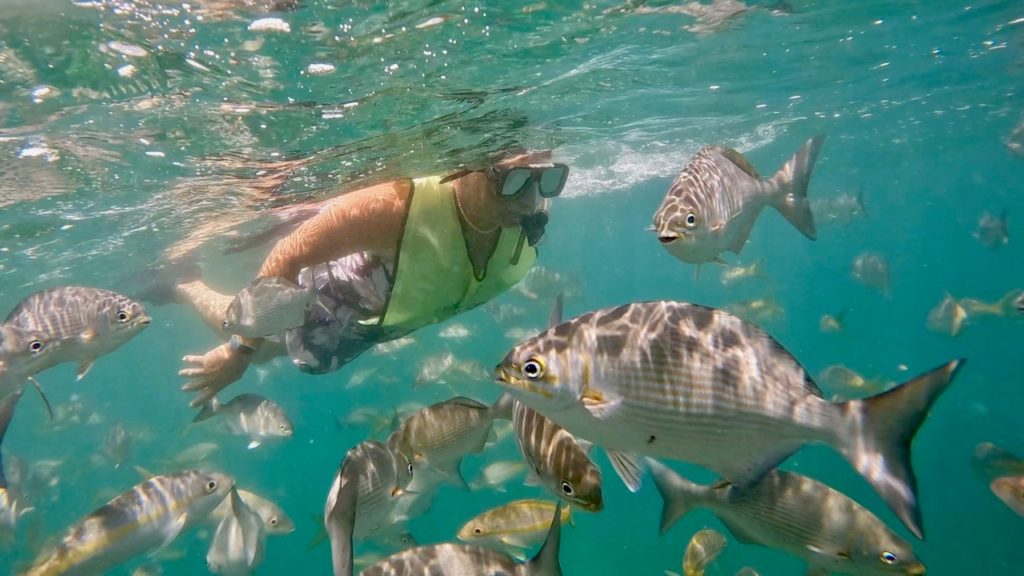

“Chickee” or Tiki bars are magical places where you might find the mayor of Marathon singing and playing his guitar. Local musicians can be heard in the waterfront tiki bars from early afternoon until closing time. It’s cool under the thatched palm fronds, a result of native Miccosukee (or Seminole) engineering. The steeply pitched roof draws heat upward and brings breezes in through the open walls. The drinks – what Jimmy Buffet calls tiki-pukey drinks – are made with fresh coconut, Florida orange juice, key limes, and island rum.
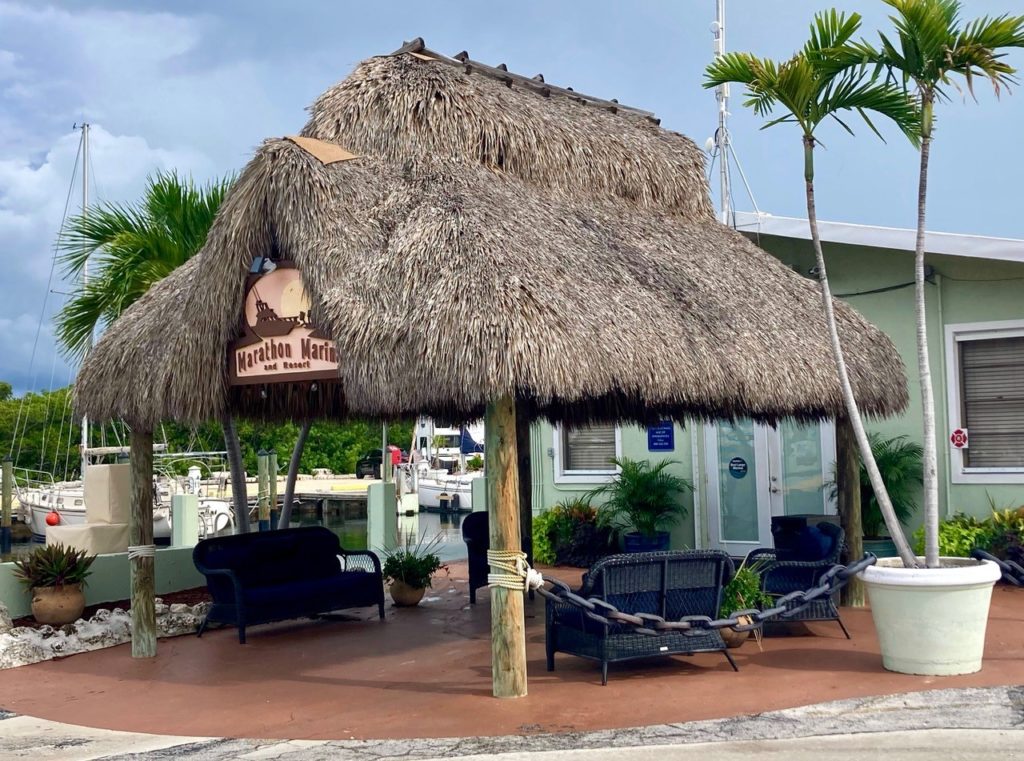
The food here is a problem for a vegetarian such as Phil. We can usually find veggie fare in Mexican restaurants and Italian or pizza places. The nearest Mexican place seems to be in Islamorada (a 20-mile drive). But for me, a seafood-eating pescatarian, options are plentiful. If the prices scare you, order appetizers. Last night I had a super delicious coconut shrimp appetizer at a fraction of the dinner cost. It was crunchy and light and came with a pina colada sauce that was dangerous to my blood sugar level. Other offerings at Porky’s BBQ and Marina were crab cakes, peel and eat shrimp, alligator bites, and of course, conch chowder. (They had a mediocre veggie burger for Phil.) Next time, we will arrive by dinghy and tie up at the restaurant’s dock.
We haven’t even started exploring all the entertainment venues here in Marathon. We went to see “Where the Crawdads Sing” at the local cinema, where patrons sit at tables and the concession stand sells beer, wine, award-winning popcorn, and nachos. It is only big enough for about 100 people, but shows first-run movies. They also have a community theater run by people who live in Boot Key Harbor. There is a turtle-rescue hospital just down the road that offers tours, and a dolphin encounter beyond that. (We encounter wild dolphins here in the harbor, so we might skip the captured dolphin show.)
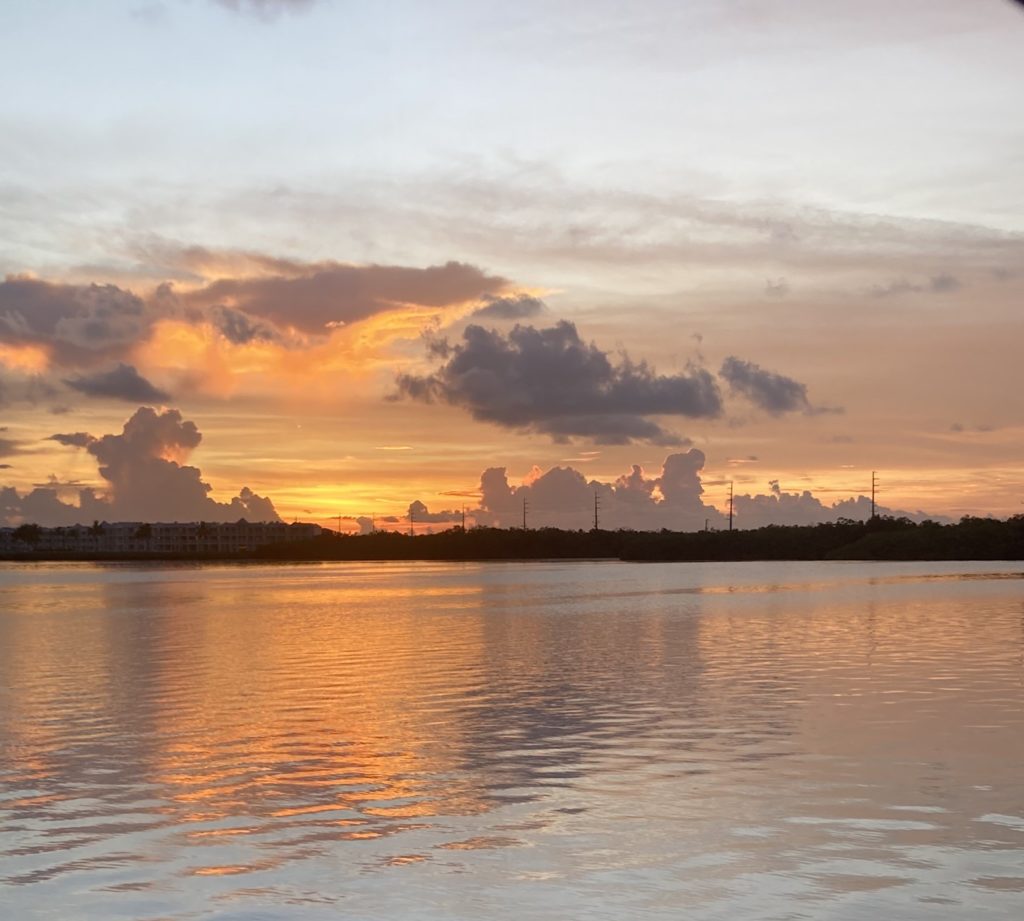

The natural wonders are the real draw for me. The sky is big here and the clouds are fascinating. Our boat’s cockpit faces the incredible sunsets and the frequent lightning storms. The bay to the west of Boot Key Harbor is very shallow, only 2 to 3 feet in most places, and features a rusting train engine that washed here from the 7-mile railroad bridge during a storm. (We call it “the little engine that couldn’t.”) It just sits there, hosting a party of birds until the tide comes in and hides all but a single spire. On that single spire, we will often see a lone anhinga bird drying its wings. This morning, we saw a great egret sitting there as two dolphins swam past.
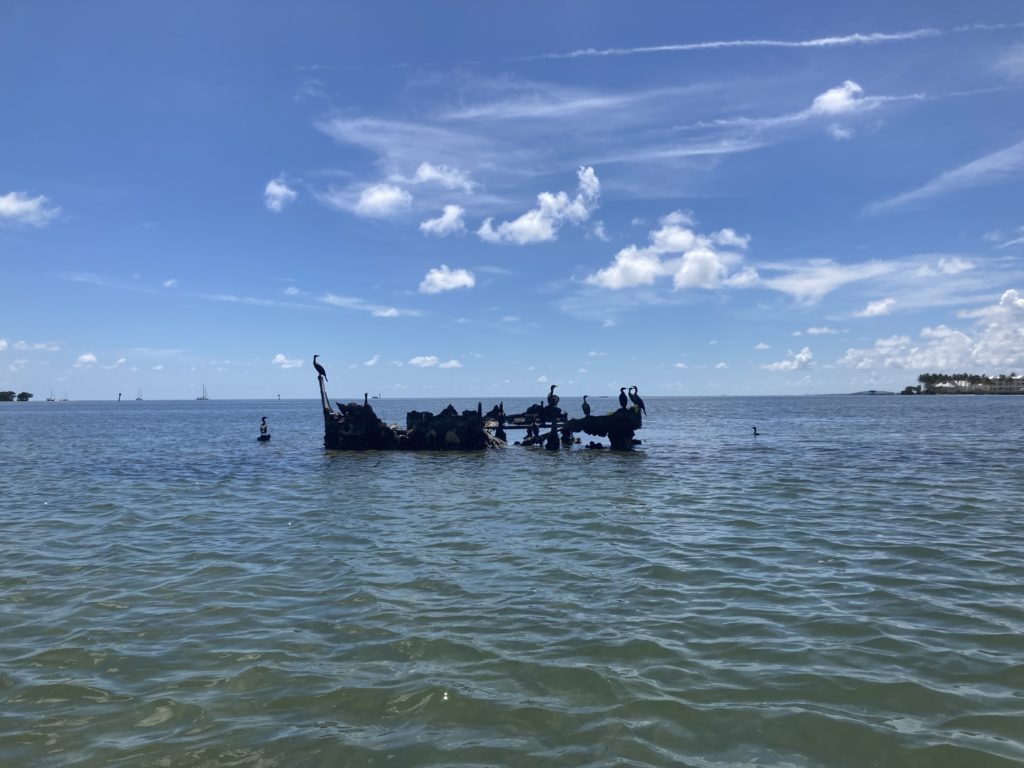
The road to Marathon goes through Key Largo, Islamorada, Lower Matecumbe, Long Key, Duck Key, and Grassy Key. Marathon, on Vaca Key, is a little more than halfway from Key Largo to Key West. All along the route there are expansive views of the shallow, light blue water on both sides of the road. State parks line Route 1 from John Pennekamp to Long Key, to Curry Hammock and Bahia Honda, with dense green mangroves protecting the narrow beachfront. When I was in college, I spent one spring break camping with two girlfriends along this stretch of wild tropical islands. I’m happy to say, it has not changed much in nearly 50 years.
In coming months, we will wander westward by car or sailboat down to the next keys and on to Key West. Along the way, we may fall in love with this place. Eventually, we will sail to other islands and leave the Florida Keys behind. For now, we are explorers – by dinghy, kayak, or sailboat. We have a lovely fleet of tropical islands to discover beneath the expansive skies, anchored in aqua waters. Through the dense cool mangrove creeks, palm-studded beaches are waiting for our footprints.

